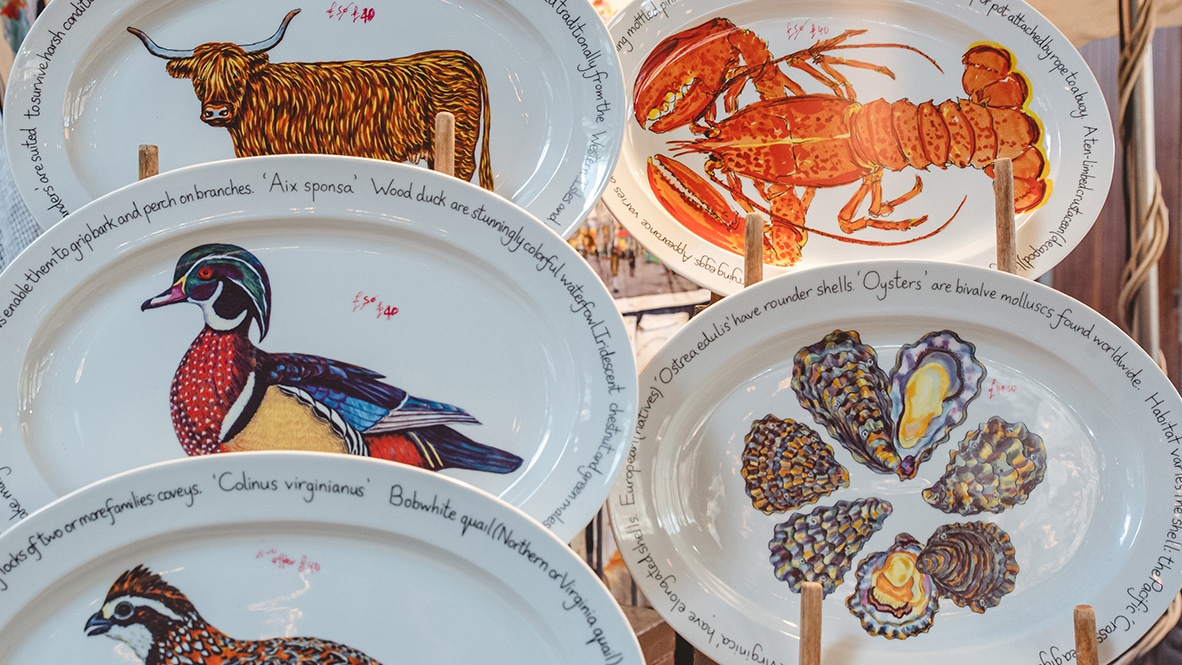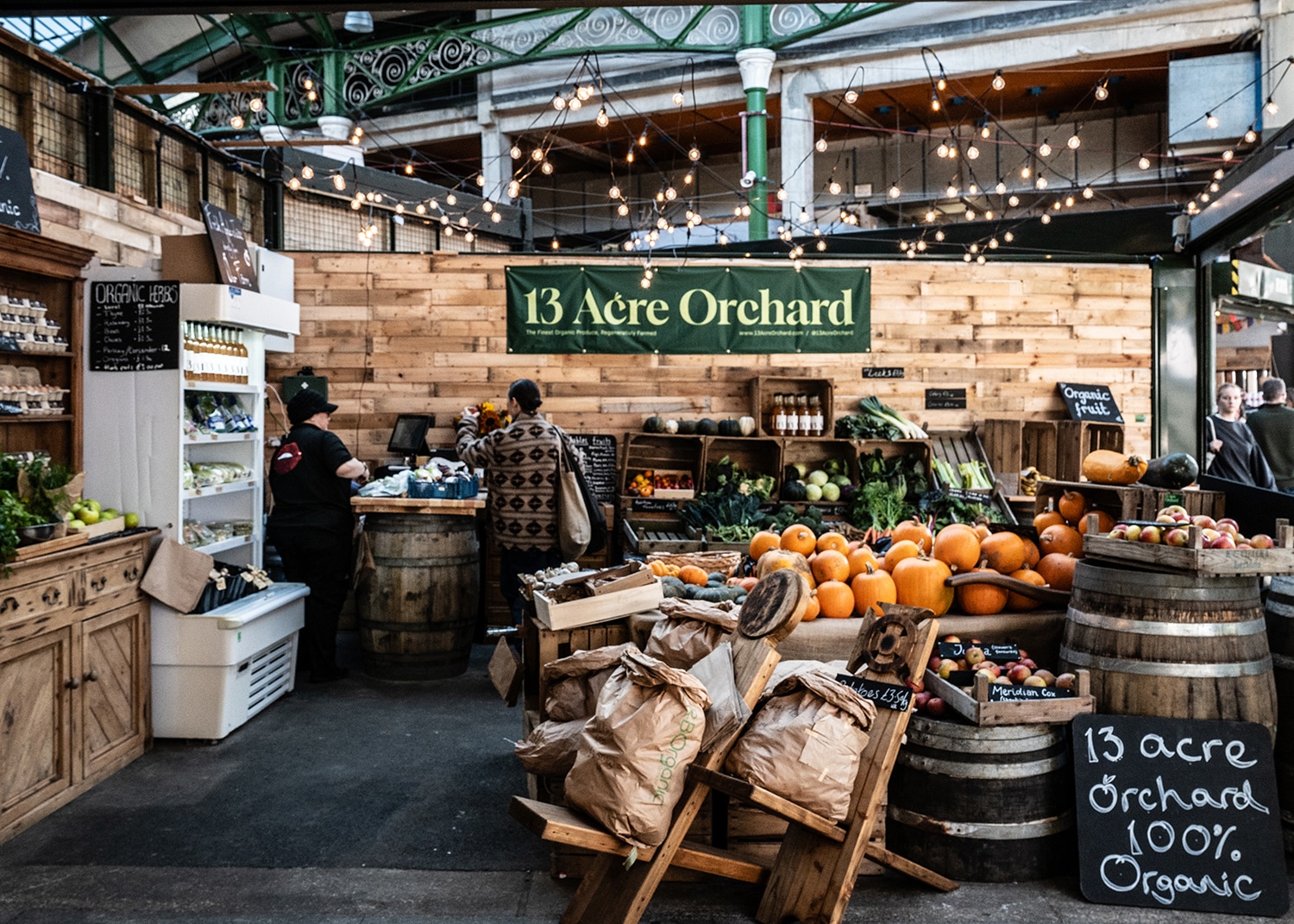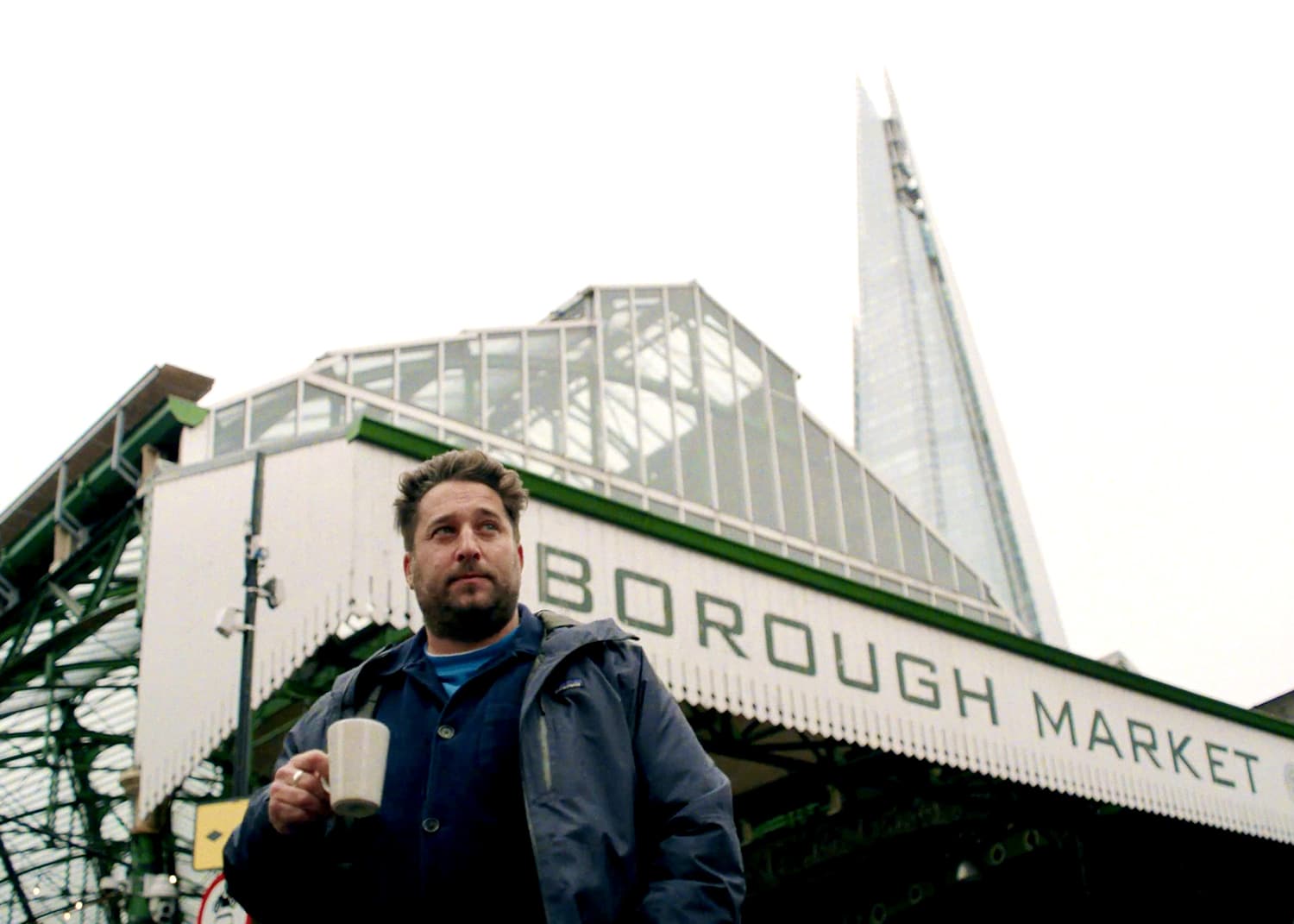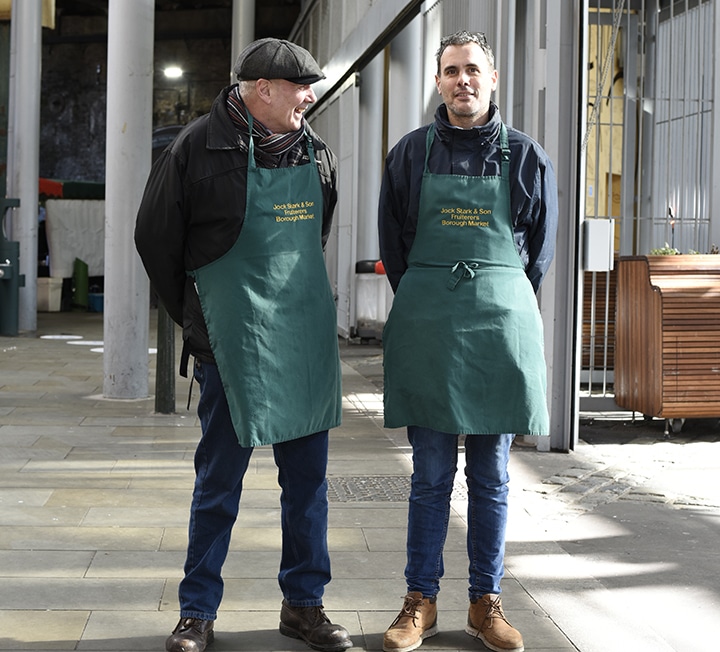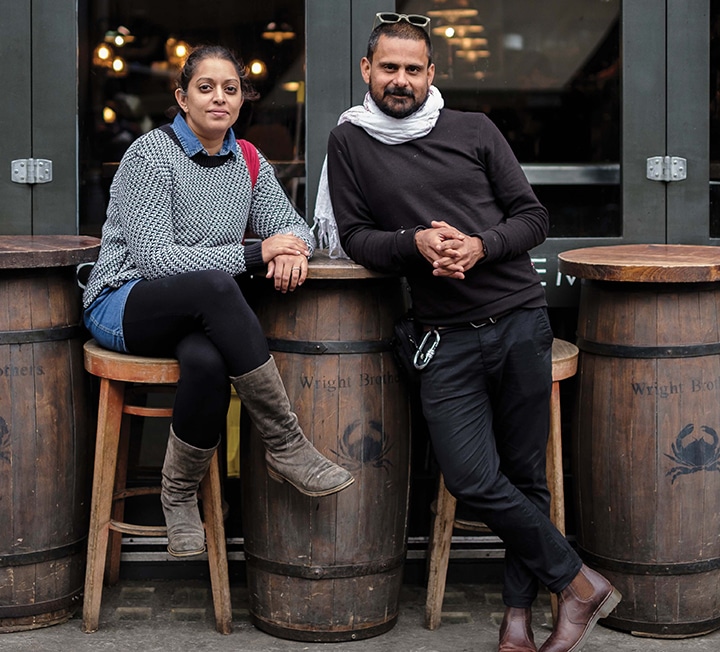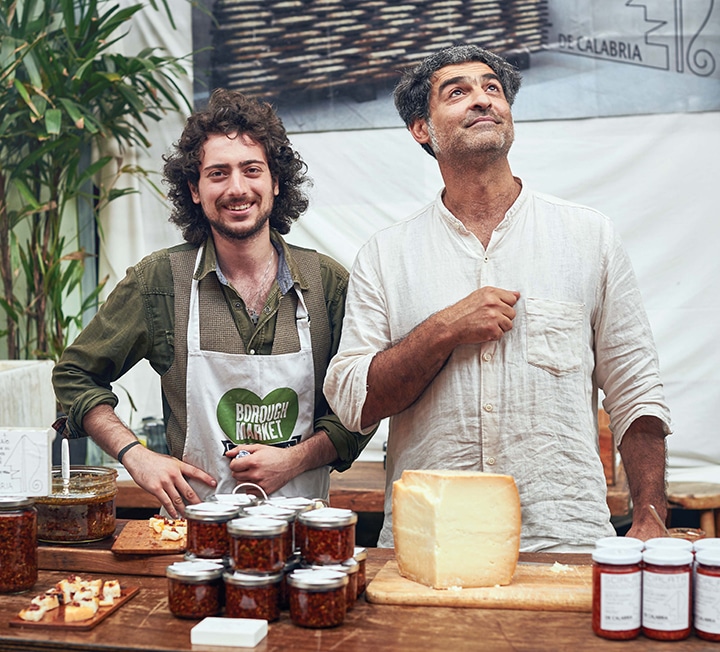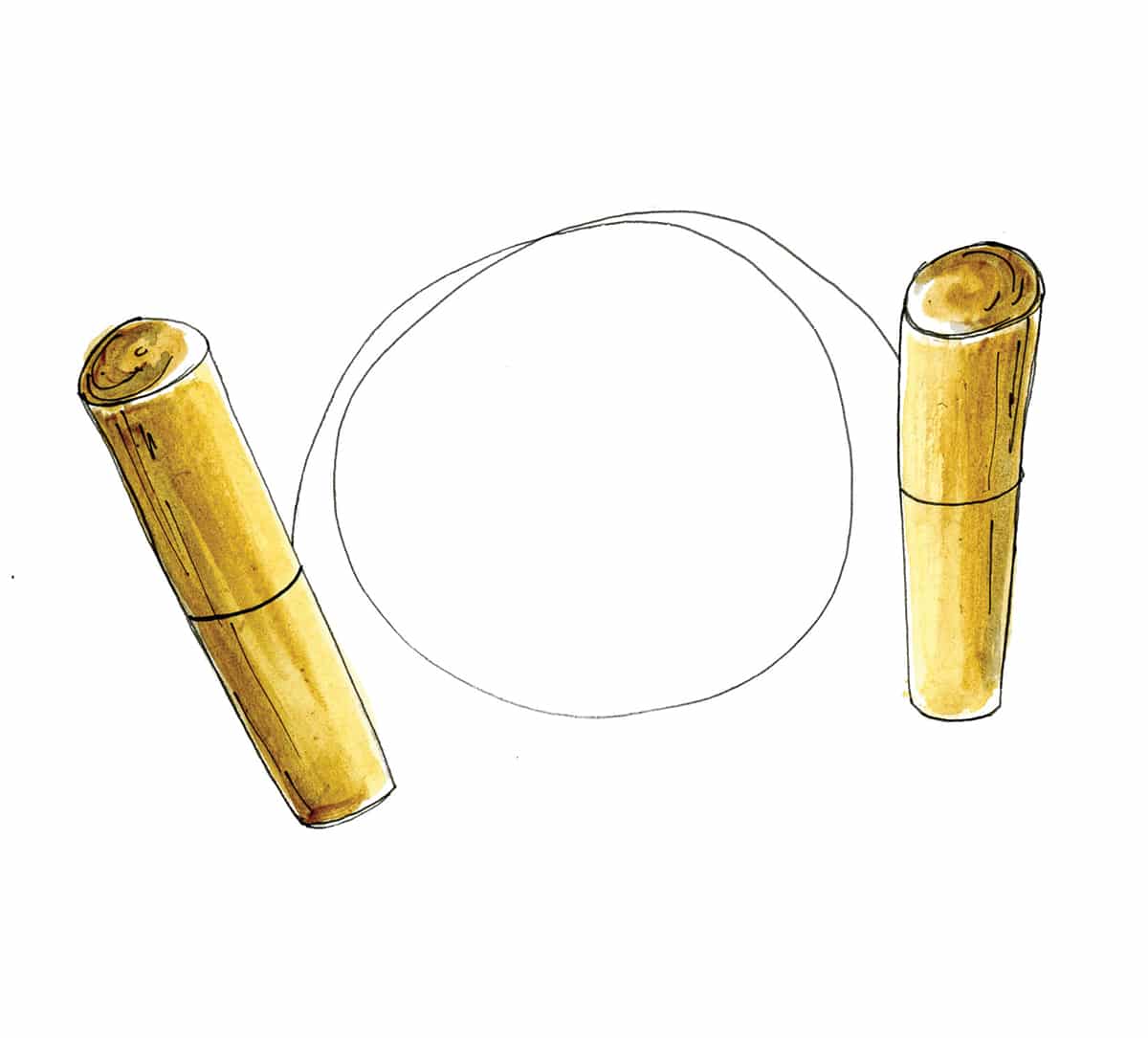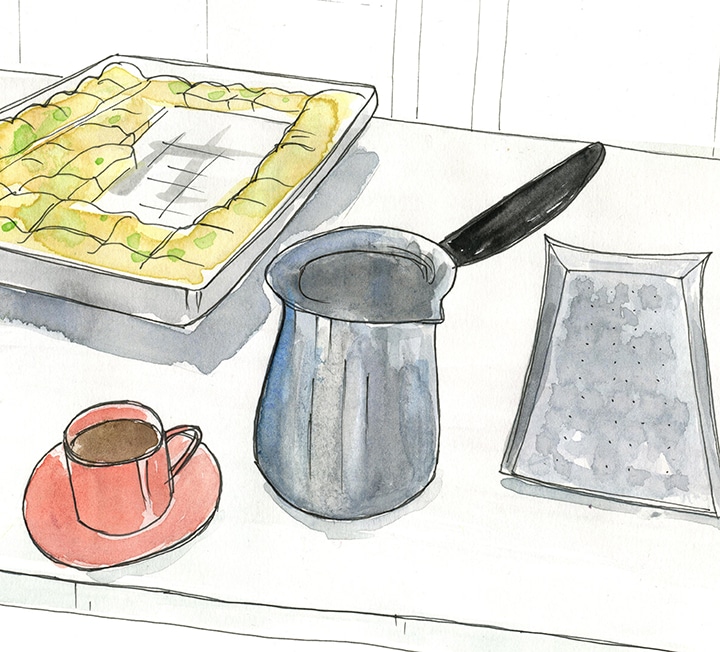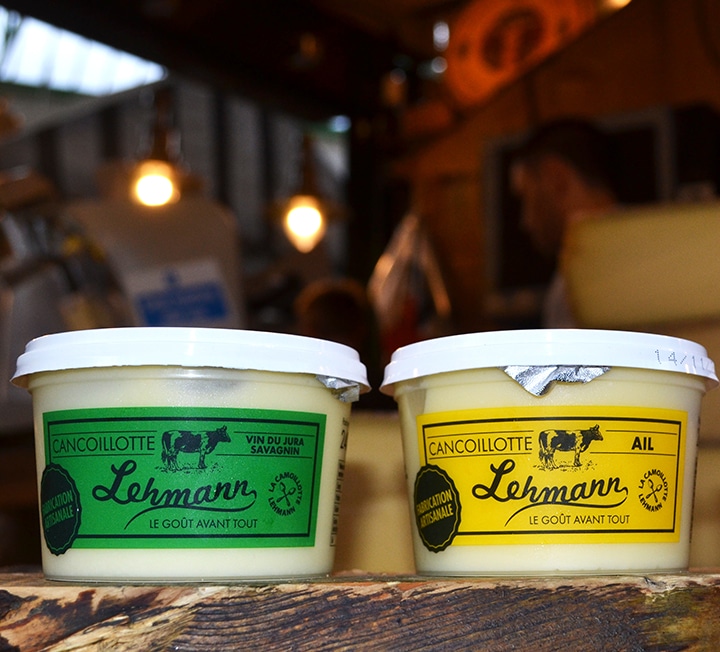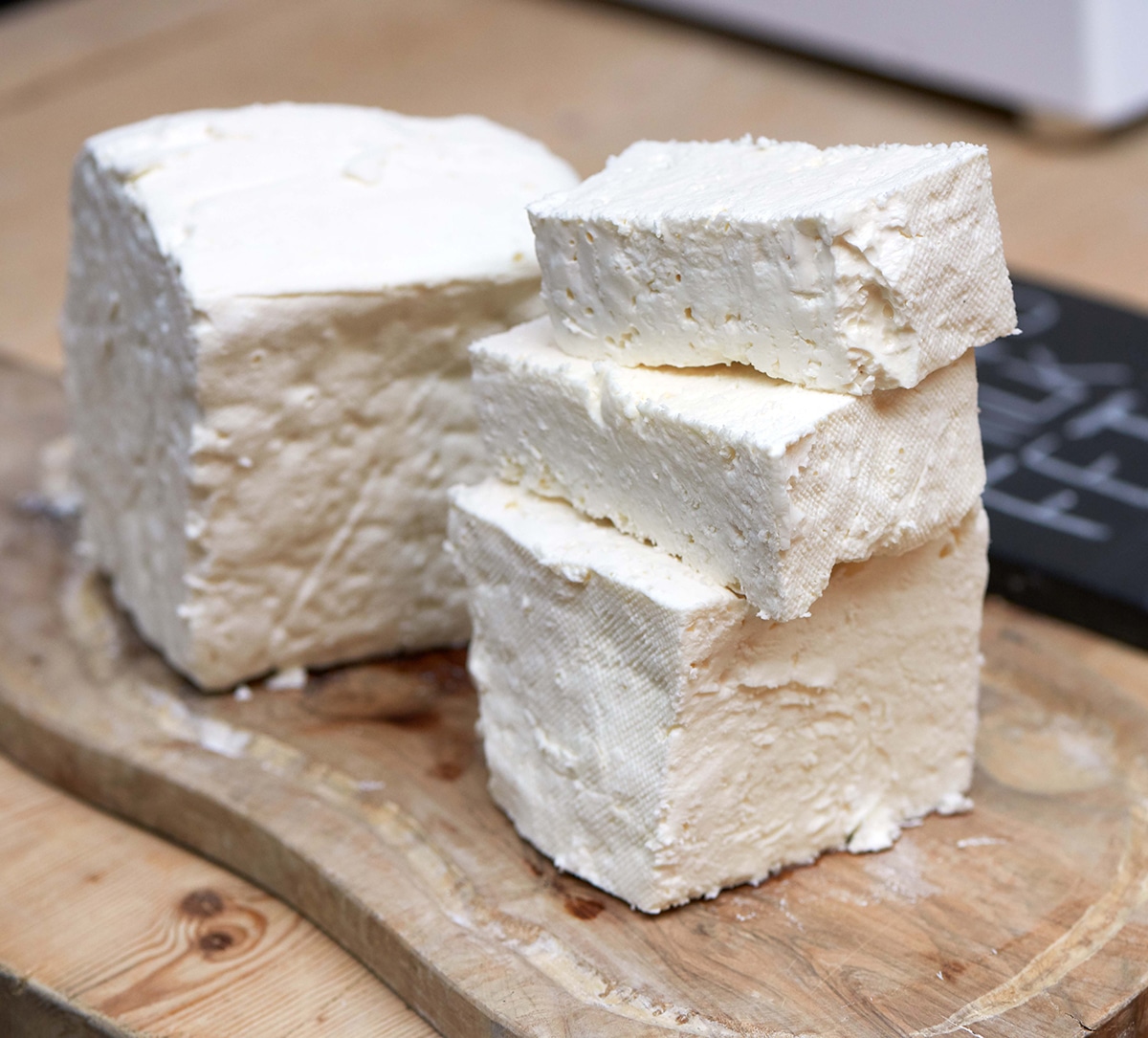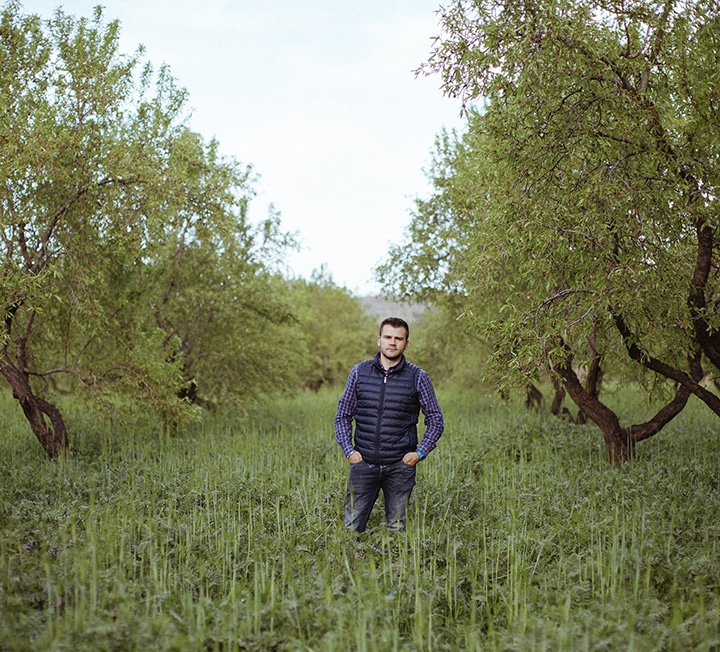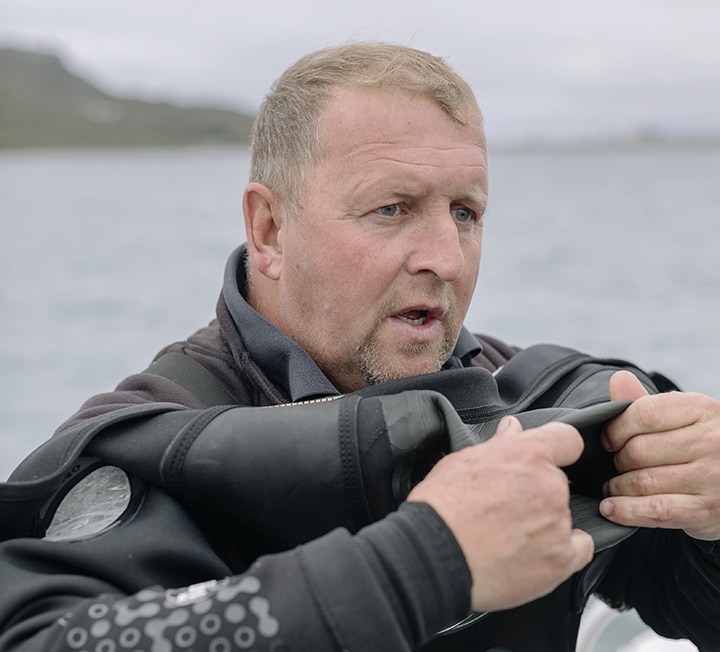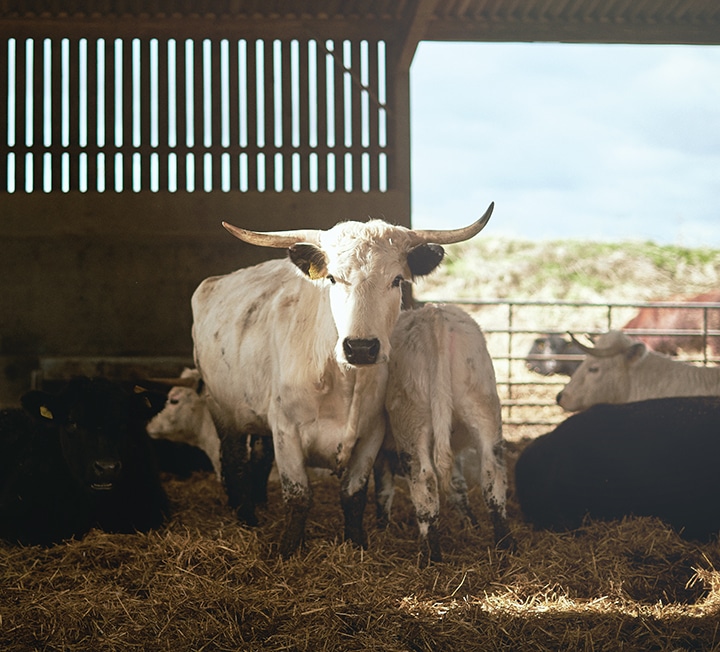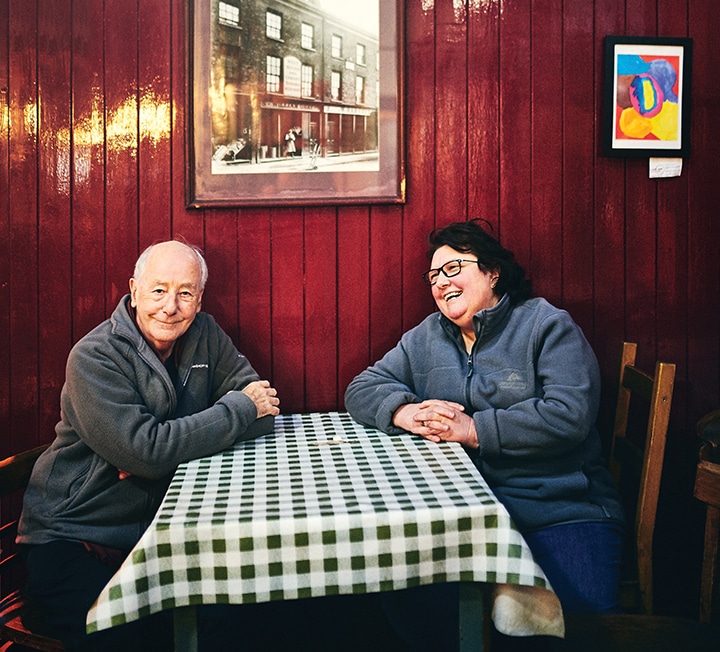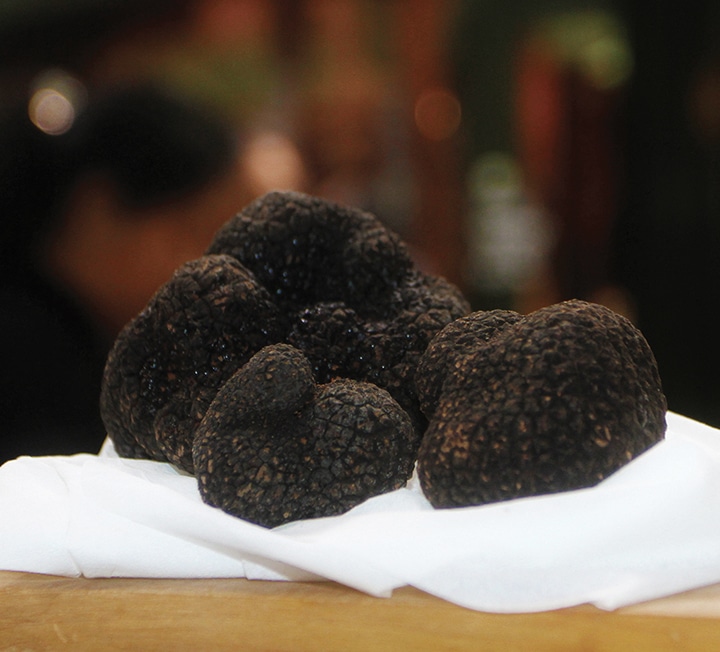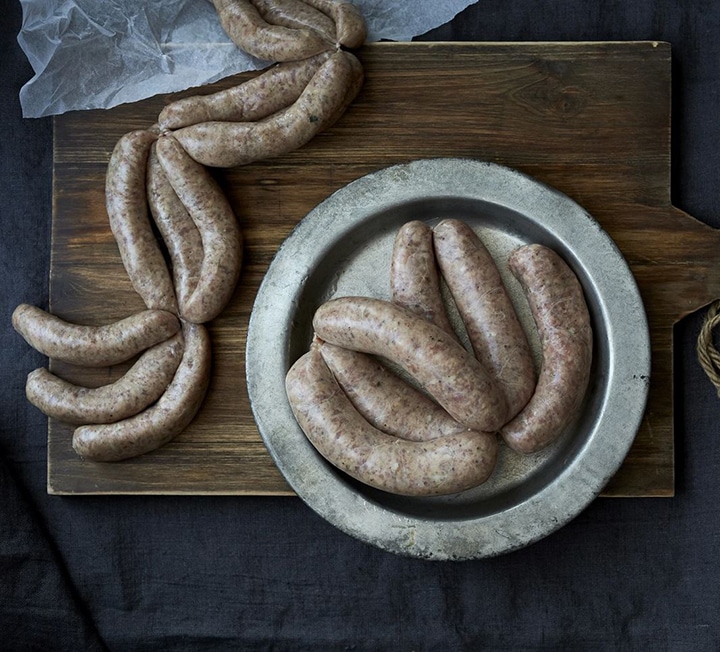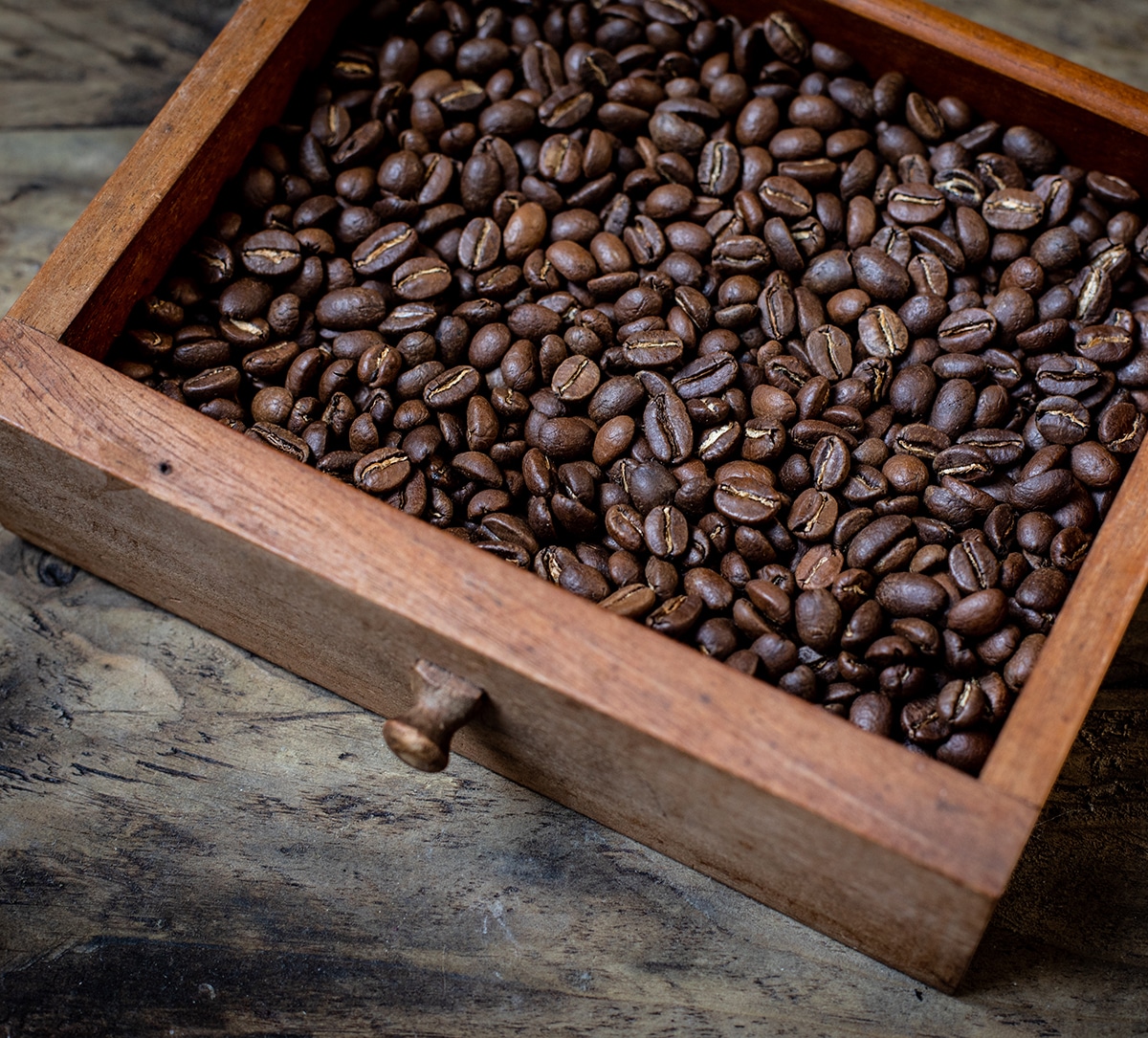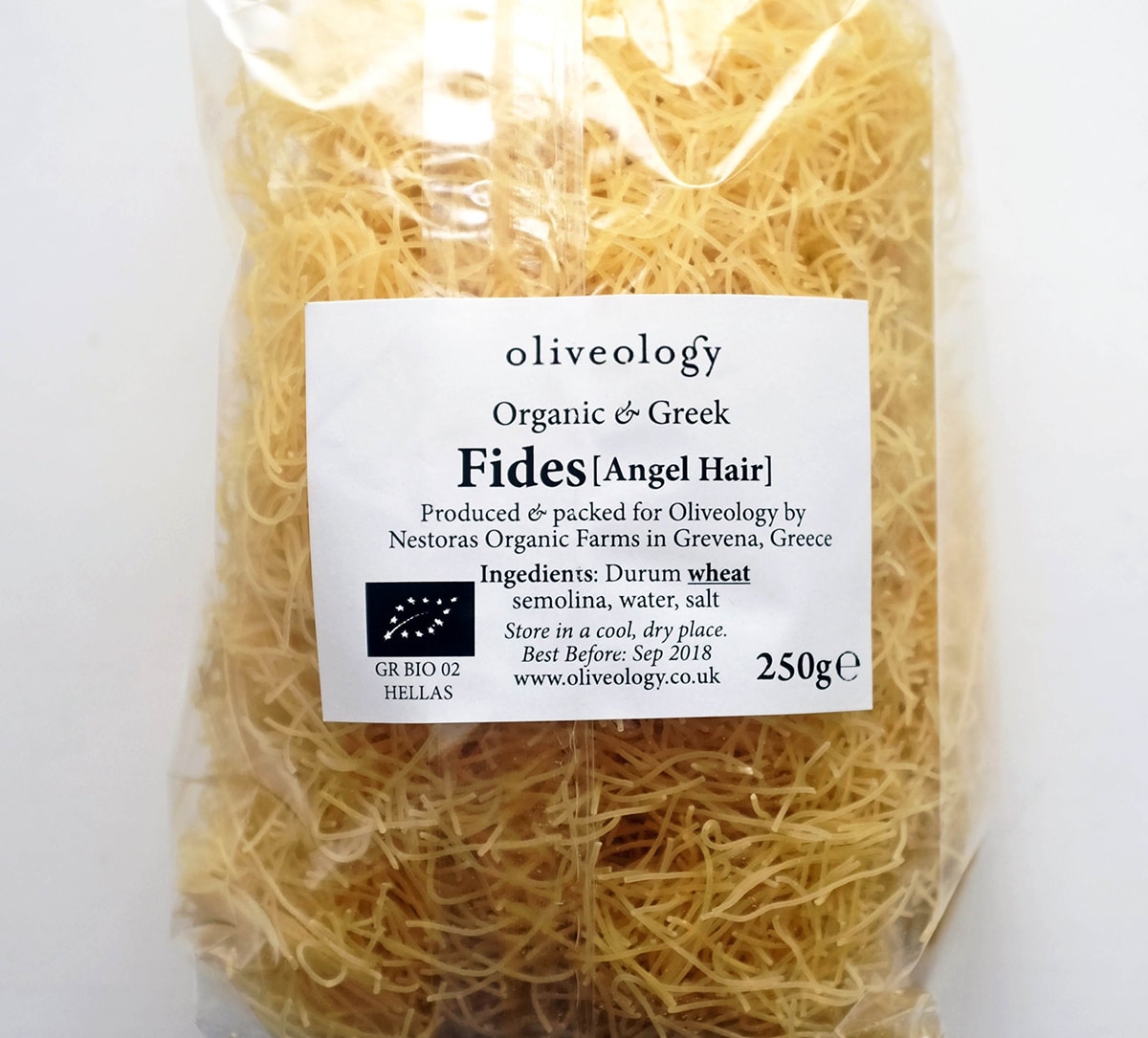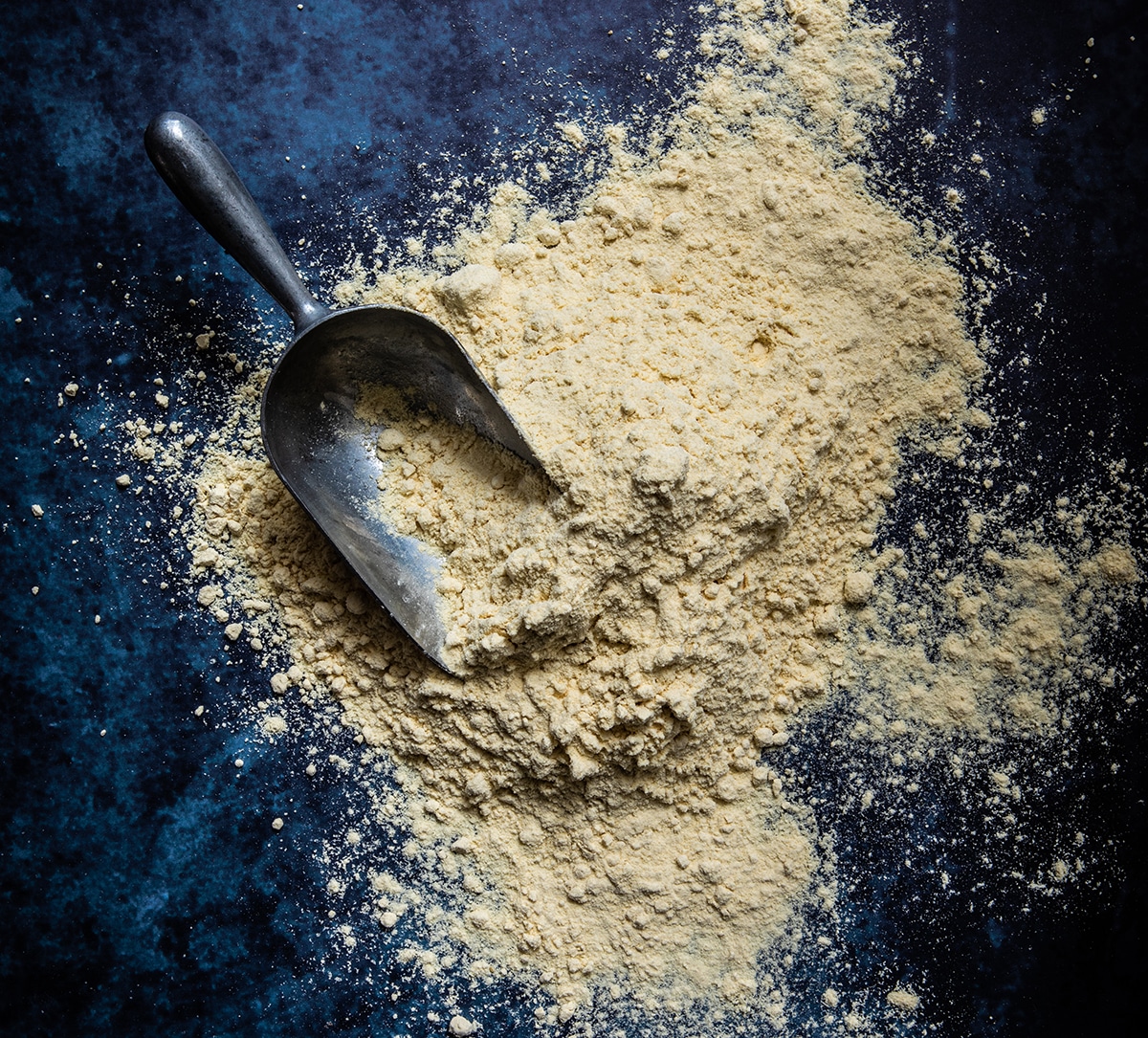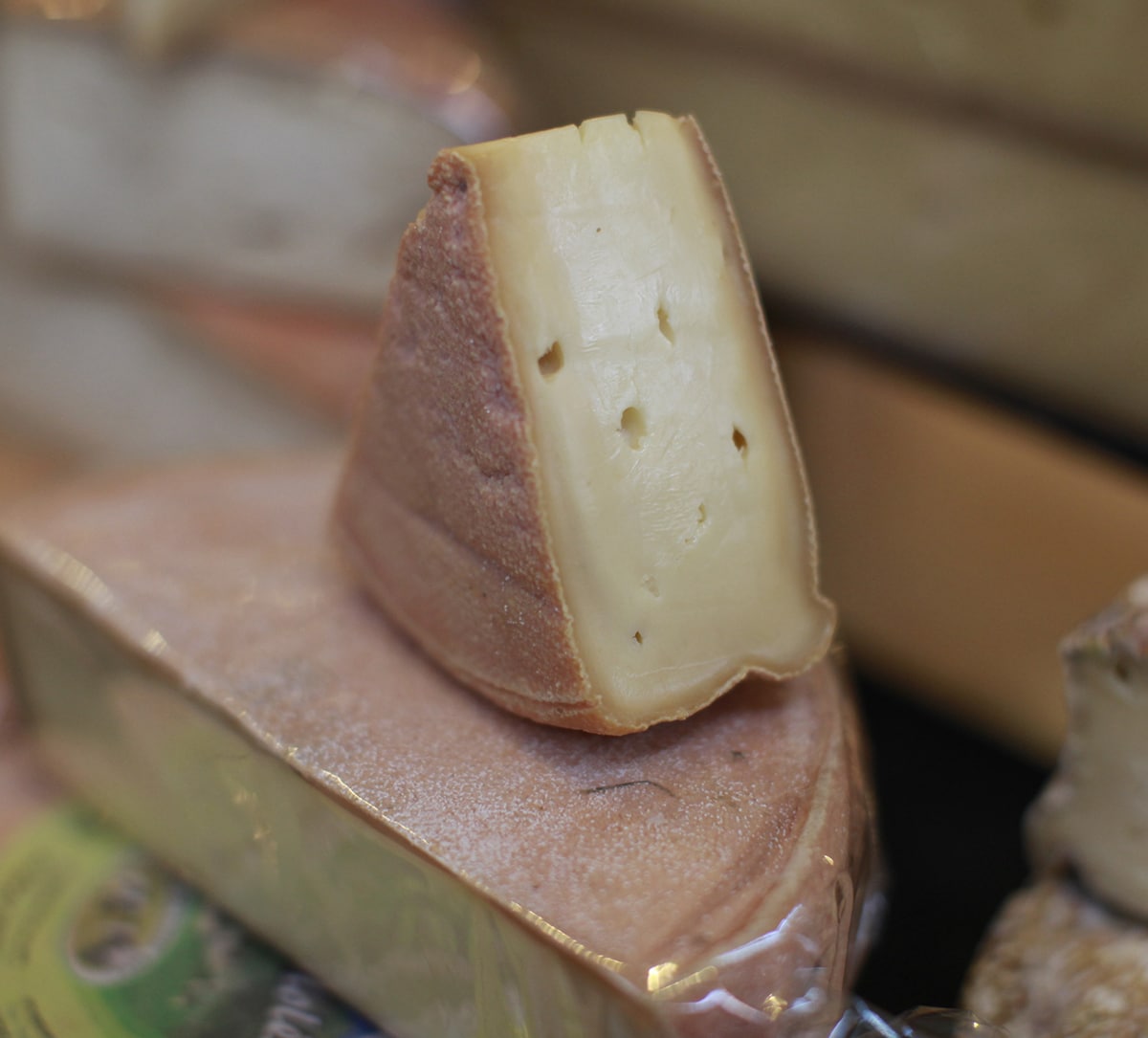Q&A: Dominic Coyte
The owner of Borough Cheese Company on British food culture, raw milk, and his lifelong pursuit of the perfect cheese
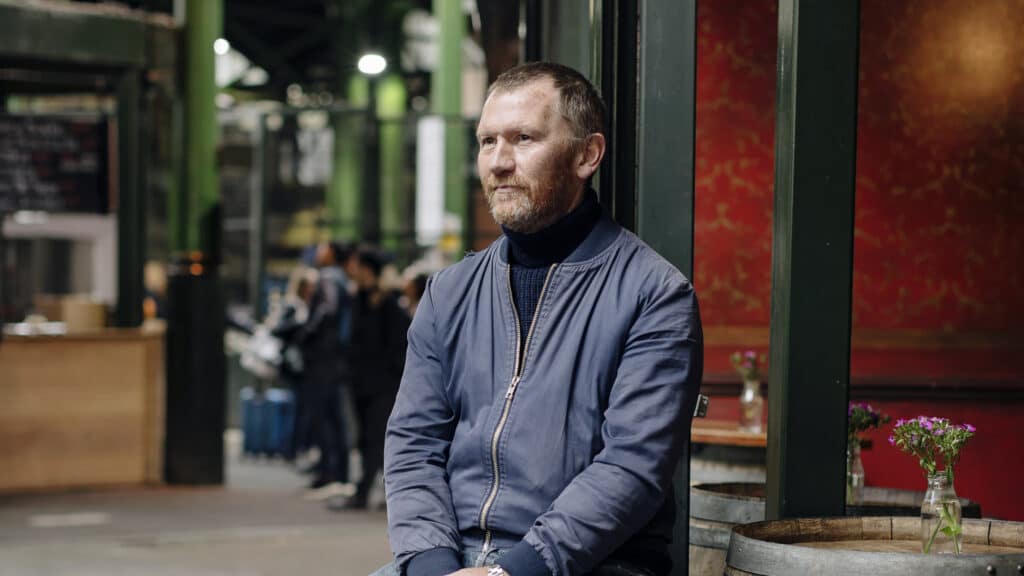

“THERE’S AN INHERENT DISCIPLINE TO PRODUCING RAW MILK THAT YOU MAYBE DON’T GET IF YOU’RE PASTEURISING”
Interview: Ellie Costigan / Portrait: Orlando Gili
How did you come to be a cheesemonger?
After I finished my master’s, I followed my girlfriend to London. Eventually she said: “You’re not staying on my floor any more, get yourself a job.” I saw Neal’s Yard Dairy’s advert in the Ham and High, which said, “Do you like cheese?” and I thought, oh yeah, I love cheese!
I went down to the shop in Covent Garden and was totally shocked by how pungent the aroma was – it was very ammoniacal. But then I tried the cheeses. They were extraordinary. I’d never had anything like them. I thought I’d be there for a year, max, but I stayed for 10.
You’re not the only cheesemonger at Borough to have learnt their craft at Neal’s Yard Dairy. What it is about the institution that draws people in?
Neal’s Yard Dairy takes what it does really seriously. It’s an innovative company, and it’s doing something really interesting. They introduced the public to a broader swathe of cheeses, made on a small scale, that can be really variable from day to day, instead of every batch tasting the same – I think it’s that natural variation that particularly interests people who have come out of Neal’s Yard. We’re all fascinated by it.
At Borough Cheese Company, you sell a small selection of ‘iconic’ European cheeses. What was the thinking there?
My friend Jason, who also worked at Neal’s Yard, went to the Jura Mountains to buy some comté and asked me if I wanted to sell it with him. This was the very early stages of the retail market at Borough Market and we saw an exciting commercial possibility here, so we left our jobs and carried on importing comté. After that, the addition of each cheese happened very organically. The second one we started selling was mont d’Or, a seasonal cheese from the same region of France, Franche-Comté. After that came tome St Antoine. We had the hard, the soft, and the tome was something in between. The gouda came fairly recently, from our friends Betty and Martin Koster, who sell Dutch cheeses in Amsterdam. Then the latest addition was the feta from Tastanas creamery in Lesbos. We wanted something for the summer months, when the heaviness of comté might not be attractive to some people – though I don’t mind it! But we’ll never expand beyond what we’re capable of looking after to a very high standard.
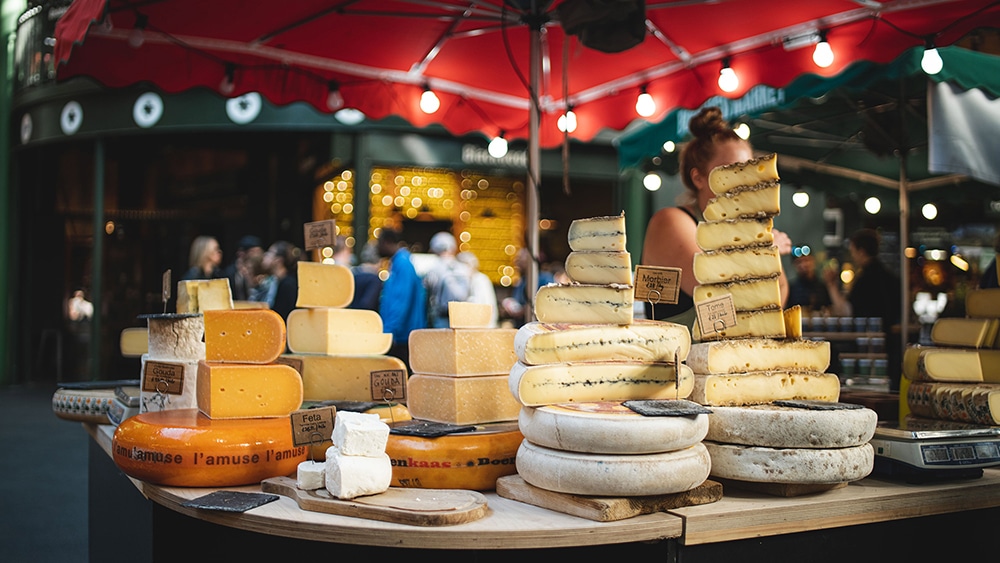
What qualities do you look for in a cheese?
Firstly, I have to love it. More technically, I look for cheeses that have a length of flavour – ones that have a good initial impact that lingers in the mouth. If you’re not left with a satisfying aftertaste, that is not the cheese I’m after. There are also various specific things you look for with each cheese. Take comté: you should be able to bend it. If you tried bending a sample of cheddar it would just snap immediately. The reason you can bend good comté is that acidification happens at a point in the process that means you do not lose as much calcium as you would otherwise, which gives it this tensile strength. If you can’t bend it, it means the make was too acidic.
With the feta, we tried a number of examples. We stayed in a monastery where it was being made by nuns. It would have been great to have bought from them, but they only made about four tonnes a year and the cheese was a bit short in flavour, a bit tight in texture – it had none of the soft, open-rangy flavours we got from the feta we eventually went for.
Is it difficult to discover producers who have found that balance between scale and quality?
I recently tried some stilton made by a guy in his kitchen, produced from the milk of a herd of eight cows. It was delicious. I asked him, “How can I buy some of this?” And he said, “You can’t. That’s not what I want to do.” To be able to sell it, his kitchen would have to be regulated, he would have to deal with all the admin, he would maybe have to employ someone else. It got me thinking about the sliding scale that exists between enabling something to be sold commercially and losing the romanticism that drew you to the cheese in the first place. I think the cheese cooperatives in the Franche-Comté have found a good way of working around it.
How do those cooperatives work?
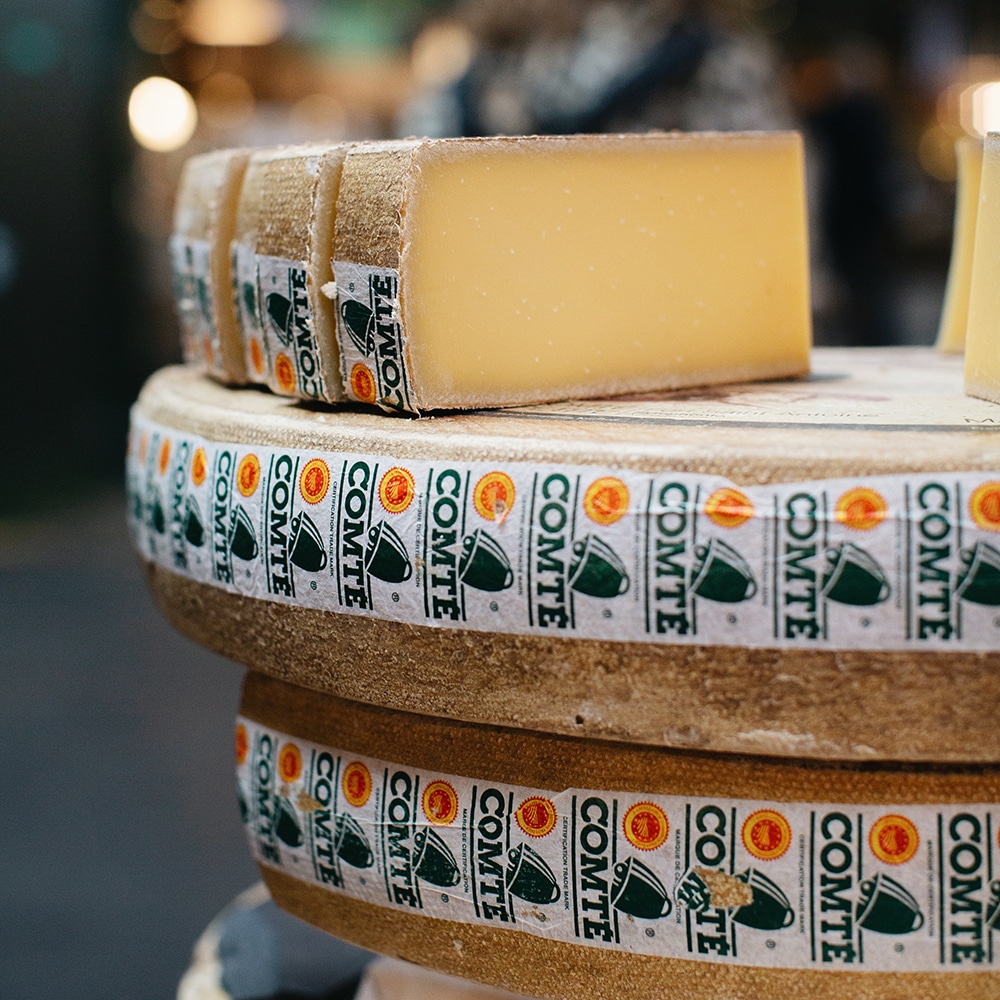
Each cheese producer – or ‘fruitière’, as they’re known in the region – works with the surrounding dairy farmers in their village. Even very small producers are making, say, 10 wheels of comté a day. They’re three feet across and 35 kilos, and they need to be matured before they are ready to sell, so where are they going to put them all? Each fruitière has a contract with an ‘affineur’ – a cheese maturer – who picks them up. The three French cheeses we sell come through Marcel Petite, an affineur who we visit every five weeks. He matures everything in an old fort, which was built in the 1880s.
There has been a boom in farmhouse cheese production in recent years. Is British cheese culture catching up with the rest of Europe – in terms of production, but also in our respect for and interest in artisanal cheeses?
It’s a big question. You have to look at the history of what’s gone on over here in the last 100 years or so. Because of industrialisation and the growth of the railways – so the ability to transport your milk as liquid rather than having to turn it into cheese – a lot of milk ended up being taken away from cheesemaking. The world wars and the rationing period consolidated cheesemaking around recipes that keep their integrity for longer, so low-moisture cheeses like cheddar. Then the last 40 years have seen the growth of supermarkets and the demand for scale and convenience. You can understand why that convenience element was attractive, but it’s to the detriment of the small farmhouse cheesemaker.
Having said that, Neal’s Yard Dairy has been going for 30 years and has helped to raise the profile of British farmhouse cheeses such that if you go to any deli in America worth its salt, they’ll have heard of Montgomery cheddar or Colston Basset stilton. That’s an incredible thing. So, it’s not all doom and gloom. Borough Market has been an amazing platform for regional cheeses and the sort of stuff I sell: quality products. Markets have a really fundamental role to play in encouraging the production of small-scale foodstuffs, whether that be bread, beer or cheese, and celebrating their variability, rather than what a supermarket does which is to say, “No, I want it to be exactly the same as last week.” There needs to be an ongoing change in cultural attitudes, which is not going to happen overnight and hasn’t happened definitively.
So, do you think cheese is undervalued?
The biggest ongoing discussion I have had over the years is about price: “I can get this in a supermarket and it’s this price.” Of course you can, but it’s going to be much younger, the quality isn’t going to be anywhere near the same, and you don’t have me looking after it and sharing it with you at its best. it’s important that people understand that.
The value of milk is a problem, too. The last figures I read, they reckoned the average cost of producing milk was about 25p a litre. The price paid to the farmer was about 22p a litre. It’s shocking. Every year you look at the figures and there are fewer dairy farmers than the year before. We have to value it more.
In the USA, Australia and New Zealand, for example, the use of raw milk is effectively banned. What are the arguments in raw milk’s favour?
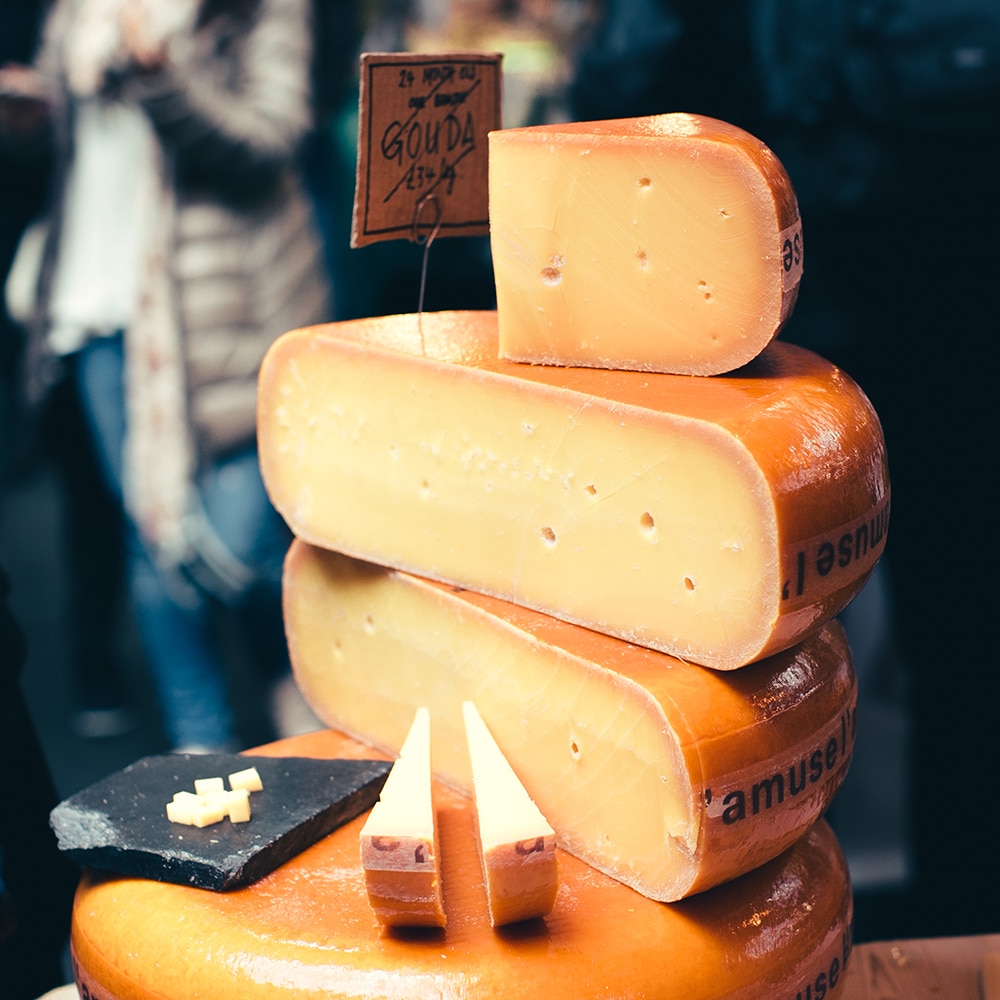
One important change that’s happened over here in the last 30 years is the establishment of the Specialist Cheesemakers Association. One of its functions is to gather people together to think about raw milk: what’s happening with it, how safe is it? I think some of the conclusions would surprise people. With good systems of manufacturing and hygiene, there’s nothing inherently dangerous in raw milk – and the benefits in terms of flavour are huge, which in turn can stimulate interest in cheese. In fact, there’s an inherent discipline to producing raw milk that you maybe don’t get if you’re pasteurising: why bother being so scrupulous about things if at the end of the day you’re going to pasteurise the hell out of it. Raw milk is great, you just need a system where you have total trust in the procedures and processing.
Do you think the treatment of animals in the industrial dairy sector is a problem?
I think the dairy industry has lots of questions to answer, not least about animal husbandry. In some of these big dairies, they’re taking 50 litres a day per animal. There are only so many milkings they can endure before they’ve had it. That is not good. Nor is the amount of land we are using to grow cereals to feed those animals. I’m not an agro-economist, but I think we need to strike some kind of balance between growing enough to make a successful business, and gearing it to the local economy.
One of the problems is supermarkets – these massive leviathons that need constant feeding. Imagine the infrastructural difficulty in trying to supply this cavernous appetite via smallholdings. They just cannot do it, they’re not geared up for it. Which is why I think Borough is so important. It offers a template for a way of retailing that’s outside the norm. People will say, “Well, look at the average protein intake of the individual – it’s gone up thanks to supermarkets, and nutrition is much better.” That’s a very good thing, obviously, but there’s got to be some middle ground.
On a lighter note, is a 12-month aged comté the perfect cheese?
I do like that creaminess and the nutty flavours you get. Over the last few years, I have noticed a trend for people wanting older comté. In my opinion, a lot of older cheeses can have a very strong impact, but without much complexity – it’s a hotness, like a spice, the range of flavour is lost and the mouthfeel less sophisticated. But these are just trends: we have to stick to our guns and believe in what we do.
Are you still as in love with cheese as ever?
I’m a cheese nut. By 11 o’ clock I think, where is the cheese?! I’ve got to have some, now. I never get bored of it. Every day is just a new day to eat cheese.
Q&A: Dominic Coyte
The owner of Borough Cheese Company on British food culture, raw milk, and his lifelong pursuit of the perfect cheese


“THERE HAVE BEEN TIMES WHEN THINGS HAVE BEEN DIFFICULT, BUT HE HAS ALWAYS BEEN THERE, LOOKING OUT FOR ME”
Interviews: Viel Richardson / Image: Christopher L Proctor
Maria on Mike
I have known Mike since my late teens, so we have been friends for a long time. I remember when I first saw him walking past the cafe and up the street. He had long hair then, so you can see things have changed a bit!
Ours is a deep friendship, one where we can be completely relaxed in each other’s company. There have been times when things have been difficult in my life, but he has always been there, ready to give support without question, looking out for me. When my parents had passed and the cafe moved to a small space next to the Southwark Tavern, Mike came up and said he would paint it for me to help with the setting up. I didn’t have to ask. There are other times when he has just said something encouraging when I have been down. We also make each other laugh a lot.
Mike knows so much about art and music, but he has a way of talking which is not overbearing or patronising. I find it very comfortable, listening to him talk about subjects that I don’t know a great deal about, but find fascinating. It is also really nice to spend time talking to someone with expertise that is completely different from food.
Sometimes we go to his place and he plays the piano, which I find very moving. The first time I heard him play, it really affected me. I was crying one minute and laughing the next. It was lovely.
My favourite painting of his is a view from Park Street. In it are my parents, standing outside our old cafe, looking towards the Market. That obviously means a great deal to me. That cafe was our home, it was where I grew up as a child. In the painting it is very much alive, and you can feel the atmosphere of the street. It is a very positive picture, full of sunshine.
Mike spends a lot of time in the Market. I think he is inspired by the buildings, the atmosphere, the people, and also the memories of people and places that were once here and have now moved on. Over the years, the pair of us have gone through a lot together and as part of the community. Those emotional attachments and shared history are still here, and they form a big part of our friendship.
Mike on Maria
When I first moved into my home next to the Market, which was a wholesale fruit and veg market in those days, I remember Maria and her sisters playing in the street right outside my front door. I remember going into her parents’ cafe and getting to know the family. The cafe was very much a key part of the community in an understated way, as all really good cafes are.
Maria is just this bubbling font of positive energy. She works incredibly hard running her cafe and setting the tone of the place. Maria’s is not just a place to eat; the customers and staff have created a community here. That is something that cannot be faked – it is a spirit that comes from being part of the history of the Market. Even though the location has changed a couple of times, what Maria is doing now is exactly what her parents achieved with the original cafe. It is unique and unlike anything else that has been in the Market over all that time. Maria brings a continuity that very few people are able to offer.
I speak to so many people for whom a visit to Maria’s Market Cafe is as much a reason for coming to Borough Market as their favourite stall. Sitting here waiting for their meal to be called out is something they have come to love. There is no standing on ceremony here; there is an honesty about the place, which is very appealing.
My favourite dish is the egg and chips. It doesn’t sound much, but you would be surprised how many people get it wrong. And of course, there is no substitute for one of her mugs of tea.
Q&A: Dominic Coyte
The owner of Borough Cheese Company on British food culture, raw milk, and his lifelong pursuit of the perfect cheese


“THE BELL SHAPE OF THE LORD LONDON MIGHT BAFFLE A FEW WHEN IT COMES TO CUTTING ETIQUETTE”
Interview & illustration: Ed Smith
At Alsop & Walker, Lord London is our best-selling white bloom cheese. It is made using the mould of a Spanish cheese called ‘tetilla’, which means nipple – though it’s probably more like a bell shape at first glance. My business partner Nic had lived in Spain for a while, so he and his wife wanted to try making tetilla, which I wasn’t familiar with. He brought some back, and to be honest I didn’t really like it. But I did like the shape, so we decided to make a variation that was more to our taste.
The moulds we use are the same as for the Spanish cheese – we bought them from a Spanish supplier – but the shape is the only similarity. Our cheese is far more exciting on the palate. On the outside, it has a white bloom similar to a brie or camembert. Inside, it’s a similar texture to a brie, though taste-wise it’s a cross between the two. It’s neither one nor the other. In fact, I’d say it’s unique.
The milk, a mixture of friesian and guernsey, comes predominately from three farms local to us in East Sussex. Because the guernsey milk is so rich, our acidification process is quite slow, which results in complex, layered flavours coming through. The fresh milk goes in the vat and is inoculated with various bacteria and yeasts. Quite quickly, the milk splits into curds and whey – the curd is what becomes cheese. When we cut the curds, we salt them, then push them into the tetilla moulds. These are basically stacked on top of each other within a cheese vat, which helps to press the curds. We monitor the pH of the cheeses continually for about 24 hours while they are being pressed. During that time, they lose a little moisture, develop acidity and become firmer, and when they’re at our desired level of acidity, we turn them out of the moulds and stack them on shelves in the maturing room.
After about seven days we start to see white mould growing on the cheese. Two to three weeks later they’ll be ready to wrap. The cheese will carry on maturing, getting softer and softer over another two months. We tend to make around 300 Lord Londons in every batch, as we have 320 moulds. The bell shape of the Lord London might baffle a few when it comes to cutting etiquette. The shape certainly creates a new angle to the great debate of whether or not it’s polite to cut the nose off a wedge of cheese! But for the record, I tend to cut slices from the cheese as if I was cutting a cake – from the point of the bell, straight down the middle.
Blessed are the cheesemakers: Isle of Mull cheddar
Clare Finney tells the story behind a flavoursome raw milk cheddar from Neal’s Yard Dairy, made the old-fashioned way by a family of farmers
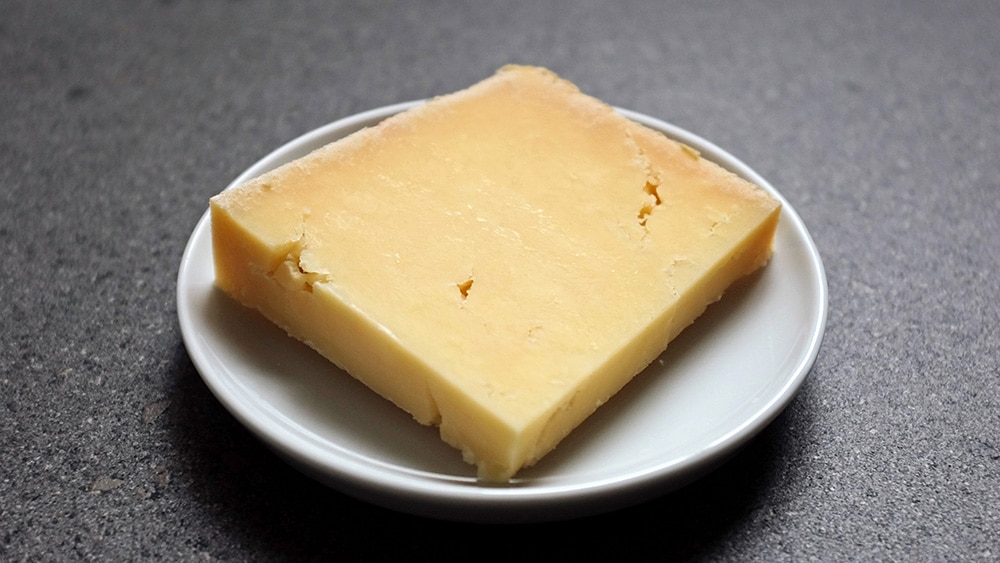

“TO CALL IT A CHEDDAR SEEMS ALMOST AN INJUSTICE WHEN ONE CONSIDERS THE PAUCITY OF GOOD CHEDDARS IN SUPERMARKETS”
Image: Ed Smith
It was 1983 when the Reades first clapped eyes on the roofless, derelict farm that would become their home: a battered yet beautiful place on the Isle of Mull, off the west coast of Scotland. They’d noticed on previous visits that the islanders didn’t have their own local milk supply. “Milk came by ship or freight to the shops on the island. There was no serious producer,” recalls Chris Reade, who moved there with her husband Jeff and young sons Garth and Brendan. Once the Reades got Sgriob-Ruadh or ‘red furrow’ farm up, roofed and running, however, that started to change, thanks to their growing herd of bounteous British fresians, which were eventually followed by a colourful mix of brown Swiss, Swedish and Norwegian red breeds.
Fast forward to the present day and the Mullochs, as the islanders are known, continue to enjoy the fruit of the Reades’ labour – albeit no longer in liquid format. Milk now being readily available, the family has focused their attention entirely on the production of cheese. In doing so, the Reades have developed one of the most remarkable raw milk cheeses in Scotland, if not in all the British Isles: Isle of Mull cheddar.
To call it a cheddar seems almost an injustice when one considers the paucity of good cheddars available in supermarkets. But if anything could restore the name cheddar to its former glory, it is this richly mature, robust number – as far removed from industrially produced cheddar as the Isle of Mull is from our harried, smoke-chocked capital.
“Each batch is very different,” says Phil, a cheesemonger on Neal’s Yard Dairy’s busy shop floor in Borough. “Sometimes it has a lovely spikiness to it – that tingling feeling at the back of your throat. Sometimes it is citrusy or almost boozy. It depends what the cows have been eating” – a characteristic confirmed by the now fully mature Brendan Reade, who’s since taken over the farm’s day to day running. “Our cheese is completely a result of where the cows have grazed on a given day. Every time they go to a different field, the cheese will taste slightly different.”
“One batch we tried had a slight chive taste to it – as if the cows had found some wild onions,” Phil recalls. “The one we have at the moment is quite mild, but it still has that slight spikiness to it.”
Isle of Mull cheddar is neither pasteurised nor coloured – two practices common in industrial-sized cheesemakers. The summer batches are creamily yellow, thanks to the wild grasses and flowers the cows graze on, while the winter cheeses are paler on account of the hay.
During milking, the fresh milk is transferred directly from parlour to cheesemaking vat, still warm from the udders. “It’s exciting to be making cheese in September and be selling it next June,” Chris Reade enthuses. Occasionally, in particularly mature wheels, fine blue veins will thread their way sporadically through the cheese paste – but this is a flavoursome asset, rather than disadvantage. She’s spent more than three decades making cheese with her family, but Chris still loves the big reveal, when the cheese is unwrapped and cut open. “Opening up the cloth, cutting through and not knowing what’s going to be there, it’s so exciting. It’s magic, to me.” It’s magic to Phil, too, for whom the Isle of Mull is “a truly unique cheddar”. If you’re having a toastie, he recommends adding a bit of raclette-style cheese to the mix, to make it stretch a bit. For his part, though, he prefers it on a cheeseboard, “just as it is.”
Q&A: Dominic Coyte
The owner of Borough Cheese Company on British food culture, raw milk, and his lifelong pursuit of the perfect cheese


“THE ARBROATH SMOKIE IS TO THE HADDOCK WHAT PROSCIUTTO CRUDO IS TO THE LEG OF A PIG: THE ULTIMATE IN FLAVOUR”
Images: Tom Bradley
Soaring costs, squeezed margins, social, environmental and political upheaval: these are testing times for all of us, but particularly small-scale food producers. Their traditions may be time-honoured, their practices perfected over generations, but when scale and consistency are too often valued over craftmanship, even those within easy reach of rich, global markets have had to modernise to keep up.
Not all of them, though. Certainly not Alex Spink and Sons, supplier of Arbroath Smokies to Borough Market’s Oak & Smoke. Tucked down a seaside street in Arbroath on the east coast of Scotland, their fish house looks and feels a million miles away from modernity. To enter the Spink smoking room – a murky yet strangely comforting place, redolent with woodchip and haddock – is to travel back in time not just to 1972, when Alex Spink senior decided to smoke fish rather than go to sea with his father, but to 15th century Scotland. “This is at a slightly bigger scale, but the smoking methods we’re using here have not changed really in hundreds of years,” says our host, Gary, as he builds the fire and tightens the string on the haddock fillets he prepared earlier.
Popular legend has it that in the wee village of Auchmithie, next to Arbroath, a fire broke out in a store where some salted haddocks were hanging up for preservation. Sifting through the soot and ashes to see what they could salvage, the villagers discovered the bronzed and burnished fish – and so, they say, ‘smokies’ were born. Historical fact, alas, affords no such colour: the practice was almost certainly brought over by the Nordic settlers who arrived regularly on this stretch of coast. There are striking similarities between the smoking habits of medieval Scotland and medieval Scandinavia. The name Spink – like many common to the area – has Nordic roots.
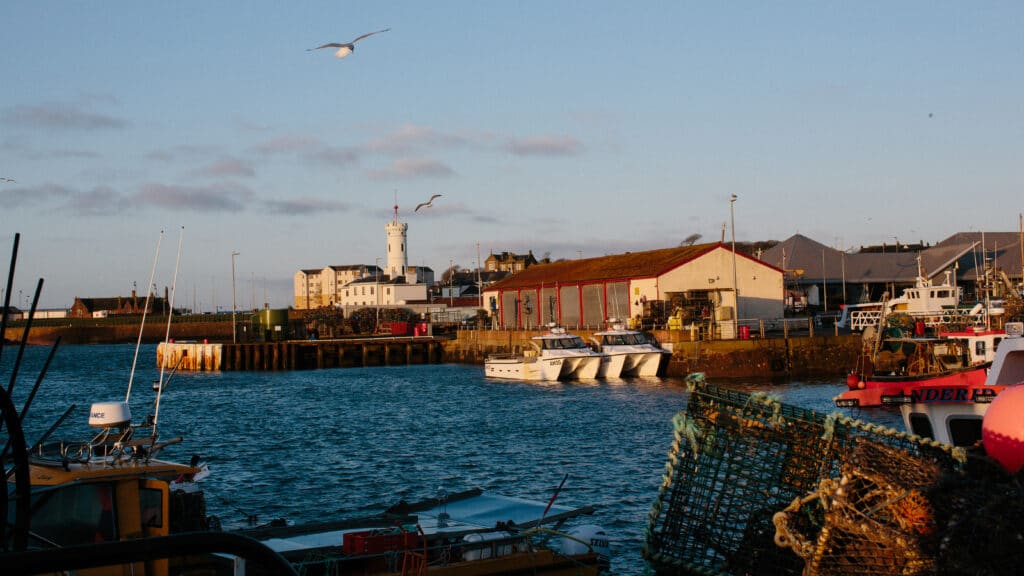
Alex Spink senior has retired, but his son, Alex junior, currently on his way back from the fish market, is keeping the family business going. Gary is not a Spink; he has, though, been working with the family since he was 14, so he’s pretty immersed in the business – particularly the smoking side of things. The haddock he’s tying now were salted three days ago, “for four or five hours – it really depends” and hung last night to firm up still further. Though the rule with fresh fish is the fresher the better (most of Alex junior’s haul will go to their fresh fish counter in their local shops), the reverse is true of smoking. “If a fish is too fresh when we try to hang it up and smoke it, it will fall off.”
This doesn’t often happen, but when it does, the lost fish, known as ‘droppers’, quickly find a happy home: “The best time to eat a smokie is straight after it’s come off the fire,” grins Gary. As he checks the string that ties the paired haddock fillets together (one hangs either side of the metal stick) he puts a pinch of salt around their tails to tighten them still further. He’s been here since 5am. It’s now 7am. The fish will go on the fire soon, and be off by 9am so the courier can collect them at noon and carry them off to restaurants and retailers. “They need to be cool enough to pack, but we want them to be as fresh as possible,” he says. Though there are several smokehouses in Arbroath, Alex Spink and Sons is one of the few to smoke every day, “so our smokies are some of the juiciest and freshest there are”.
“It takes a while to get the timings. Sometimes you can say it will take an hour and a half, but if there’s a fair bit of wind it will make the fire hotter so they smoke quicker. Likewise, if the fish are smaller. The weather, the size of the fish and the freshness of the fish all play a part in the timing,” says Gary, who developed the instincts and experience needed for his craft by spending several years observing his predecessor at work.
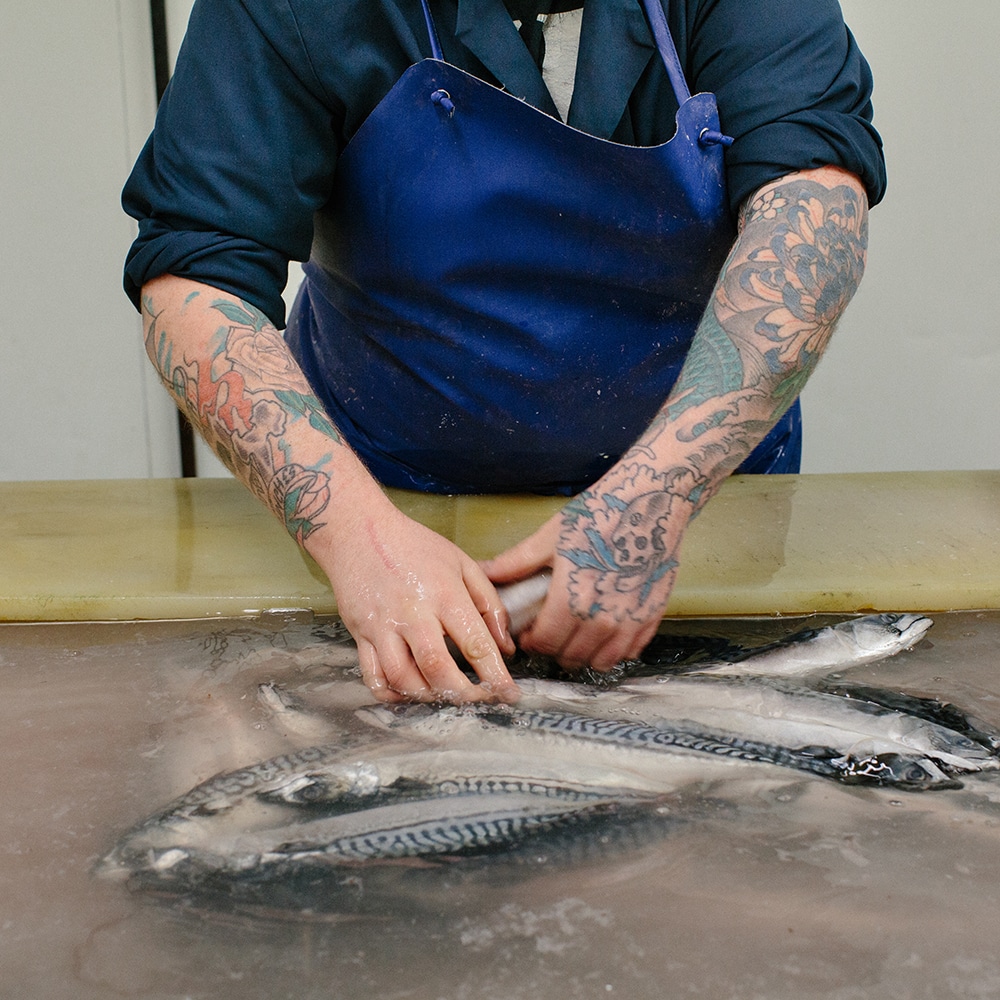
The fire lit and crackling, he returns briefly to his colleagues in the main processing area. Alex junior has returned from the market, so there are several boxes of fish to unload, unpack and fillet, destined either for smoking or for selling fresh at Spink’s local shops, where, in a display of perversity typical of people whose place of living has become bound up with a certain foodstuff, smokies don’t sell particularly well.
The filleting is all done by hand. “There are filleting machines, but they don’t work with smokies. You have to fillet, keep the backbone, and get the head off, but with minimum meat loss. Then you have to clean them.” Gary gestures toward his colleague, Ron, and the whirring brushing machine he is operating, the only piece of mechanisation I’ve seen outside the company office. In the cold, clear running water and Ron’s careful hands, each fish takes around six seconds. After this, the cleaned, filleted fish are packed into containers of dry salt to reduce the moisture, harden the skin and add flavour. The quantity of salt and timing of the immersion depends on the weight of the fish: another complicating factor in what, for all its seeming simplicity, is clearly a remarkably refined process. Part way through the salting, fish of equal size will be paired and tied together by the tail using ‘thrums’: locally produced jute string, once a by-product of Angus’s many spinning mills. Then, once salting’s complete they’ll be washed and hung on rails or sticks to dry.
Every step of this process has been enshrined in EU regulation since 2004, when the Arbroath smokie achieved protected status, a development that made a huge difference to every smokehouse in the area authorised to produce this succulent, salty speciality. Only those operating within a five mile radius of Arbroath can produce smokies – the town having been the epicentre of production since the late 19th century when the fishing families of Auchmithie moved there for its superior harbour and housing prospects – and the haddock must, bar exceptional circumstances, come from Scottish waters. “The Arbroath smokie has been described as being to the humble haddock what prosciutto crudo is to the hind leg of a pig,” the relevant regulation states. “It is the ultimate in flavour that can be achieved from the original article, and the secret, as with prosciutto, lies in the cure which gives the smokie its delicious taste combining the subtle tang of smoke with the sweet, delicate flesh of the haddock.”
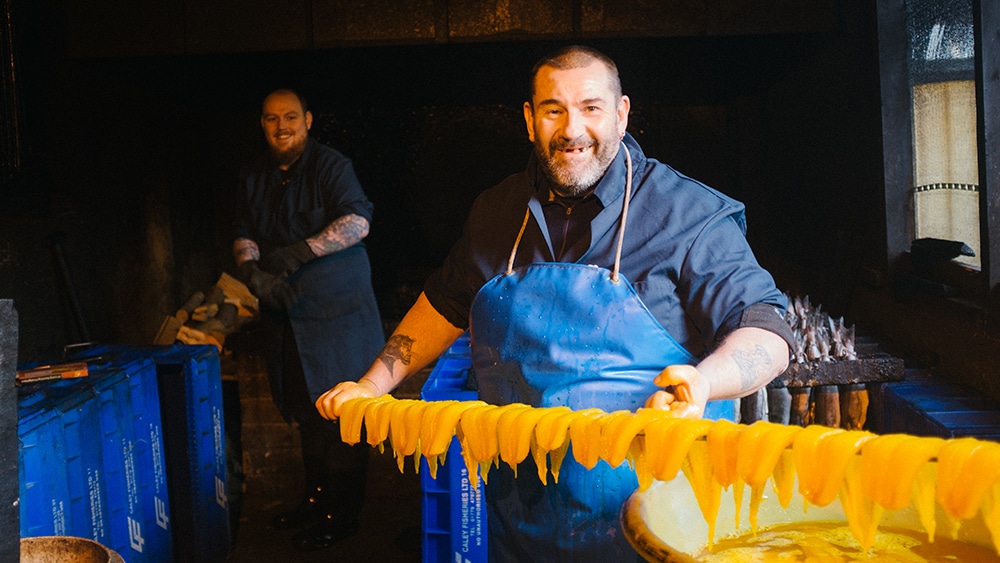
For this reason, it cannot be mechanised. “Many have tried, but it just doesn’t work,” says Gary. As the specification itself notes, smoking over an open fire “imparts a succulence and flavour that cannot be matched by similar products smoked in mechanical kilns”. By this point the fire is ready, its fuel of hardwood fully ablaze in what is still called ‘the barrel’, though the Spinks’ operation has long outgrown the whisky barrels their ancestors favoured. This makes no difference, Gary observes: “After so much use, the barrels wouldn’t have imparted any whisky flavour.” It’s the fresh hardwood that gives the smoke it’s taste, a mix of cedar and oak. “Some people have tried to use old broken-up palettes and other rubbish, but you can’t do that. The smoke is the flavour, so you need to use quality wood.”
Donning thick gloves, Gary lifts the fish-laden sticks and places them above the fierce, flickering fire. “It’s a nice, calm day without wind” he observes wryly – we’re there a week after Storm Dennis’s ‘visit’ – “but these aren’t the biggest fish, so they should take about 90 minutes.” He shuts the heavy wooden lid, another minor and fairly meaningless update on the hessian sacks historically used to trap the smoke. “Sacks are hard to source and wood is just as good. Solid but breathable,” Gary continues. Because one side of the fire is hotter than the other (“No idea why; it’s always been that way”) he’ll need to turn them about half way through the process. He sets his phone alarm and returns to the fish prep room, where Alex junior is unloading salmon: thick, pink sides, from farms in Shetland and Norway that prioritise sustainability. While Gary slices them up, we retire to the office to chat with the two Alexes: Alex senior has arrived, here to take a break from retirement by filleting fish and filling us in on his life’s work.
Forty-two years ago, when he started the business, Arbroath was still a bustling harbour, with most of the town employed directly or indirectly by the fishing trade. His father was one of them: a fisherman who in Arbroath’s heyday was “catching fish like they’d never caught before”. This was the mid-1970s, Alex senior continues. “The pair trawl had started: two boats, pulling one net between them, which dragged along the bottom and caught all sorts of fish” – a method even more damaging than the one-boat trawler. “After two or three years, the fish got very scarce – and that was the beginning of the end, really.” Trade moved to Aberdeen, and then, when that harbour fell too, to Peterhead and Shetland. Meanwhile young Alex senior had spurned the family boat in favour of fishmongery and smoking – first for another merchant, then using his father’s steadily diminishing haul.
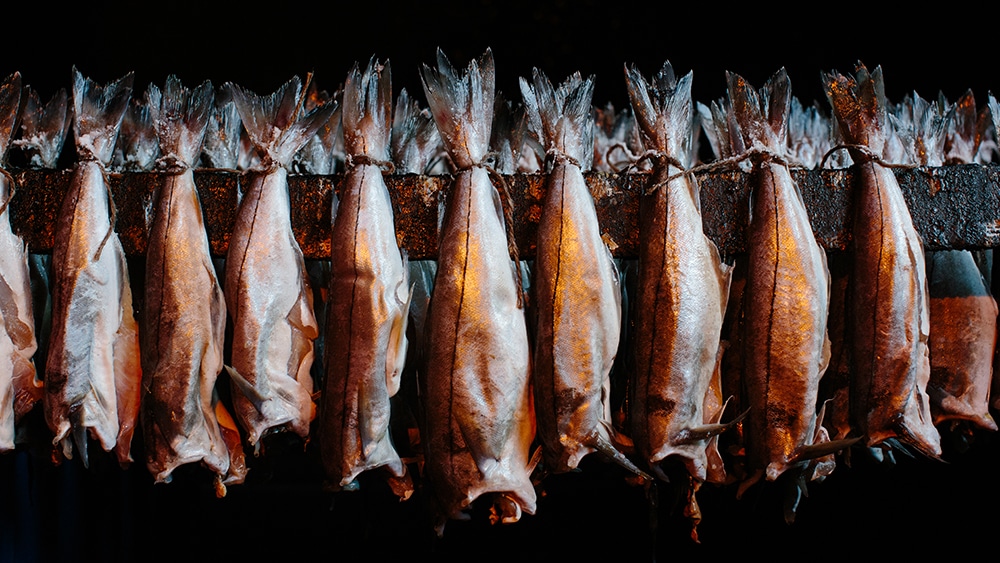
The draconian quotas introduced by the UK and EU decimated Scotland’s fishing towns, but did have a significant upside. “There are more fish now than there ever were. At one point we were having to import fish from Iceland to sell. There were no fish at all out there,” he says. Now he’s handing his business on, confident in the knowledge that Alex junior, Gary and the rest of his former colleagues will be secure in its employ. “There is a future in it now – otherwise I’d never have encouraged Alex,” he says soberly. “There are fewer boats, but they are better boats, and the fishermen are investing in it.” Not all are sustainably minded, and Alex junior is careful to buy from those certified by the Marine Stewardship Council, but there is “a lot more confidence in the industry”. That, together with the EU protected name status, has sown hope among fish merchants here in Abroath.
Gary pokes his head round the door. “The smokies are coming off the fire now, if you’d like to watch,” he announces. We follow eagerly, hoping there’ll be a dropper or two, our appetites having been stoked further by the Spinks’ description of eating them “straight off the barrel, when the flesh is juicy and moist and still warm”. In the fug of the smoking room, Gary lifts the barrel’s heavy wooden lid and disappears briefly into a billow of smoke before emerging triumphantly with a rail of smokies. Burnished by the fire, their skin sizzles slightly as he sets them down: “Sometimes I take the temperature, but I’m mainly looking for colour, and whether the skin moves.” He knows these are ready because their skins are coppery, dry and taut. Now it’s the salmon’s turn to enter the smoker: hot smoking requires more heat from the fire, so they follow the smokies, which fare best on its first, less intense flames. Gary makes toward the trays of pink fillets and, as he does so, a single solitary smokie starts to fall. He catches it just in time and, setting it before us, deftly removes the main bone so the skin splits and reveals its steaming white bounty. We fall upon it and, using our fingers, peel off jagged lumps of the flesh. It is delectable: creamy and barely-cooked, with a lingering hint of oaky smoke that complements its innate sweetness. It is like an apple eaten straight from the tree, a pea podded and popped onto your tongue. It is past and present, time and place, all in one mouthful.
Discover more
Q&A: Dominic Coyte
The owner of Borough Cheese Company on British food culture, raw milk, and his lifelong pursuit of the perfect cheese


“IF THIS WAS HAPPENING ON LAND, WHERE PEOPLE COULD SEE THE HAVOC THEY CAUSE, THEY’D STOP IT IMMEDIATELY”
Images: Orlando Gili
“Sometimes it is like looking under your bed for a pair of socks, the visibility’s that poor. If the tide is strong it’s so gloomy, you can end up bumping into things.” Other times, expert scallop diver Darren Brown of Shellseekers Fish & Game can spend a full hour and 40 minutes picking what some have likened to solid gold coins off the floor. “It’s a gamble,” he shrugs, checking his watch and putting his foot down, in a van chockful of gadgets and gizmos. Time and tide wait for no man – not even an ex-marine who, when he isn’t diving, is either line fishing or stalking deer and rabbits on Dartmoor; and with a slight kerfuffle over a hole in Darren’s dry-suit this morning (conclusion: it’s fine – “and if it isn’t I’ll know about it soon enough”) the race is on.
We pull up at the docks: the brooding grey arm of the Isle of Portland on one side, the steely grey of Weymouth bay ahead. It’s a formidable looking place, not helped by gloomy skies and the knowledge that, just out of sight on the island, lies one of Britain’s most notorious prisons. Darren’s boat is moored in the old naval base at the foot of the island, “so really I’ve come full circle. This is the base where I served as a marine. It is a bit weird, coming back here,” he acknowledges. “I walked out in 1997.” After 20 years of supplying fish and game to his stall at Borough Market, hunting and fishing have become “a way of life” for him.
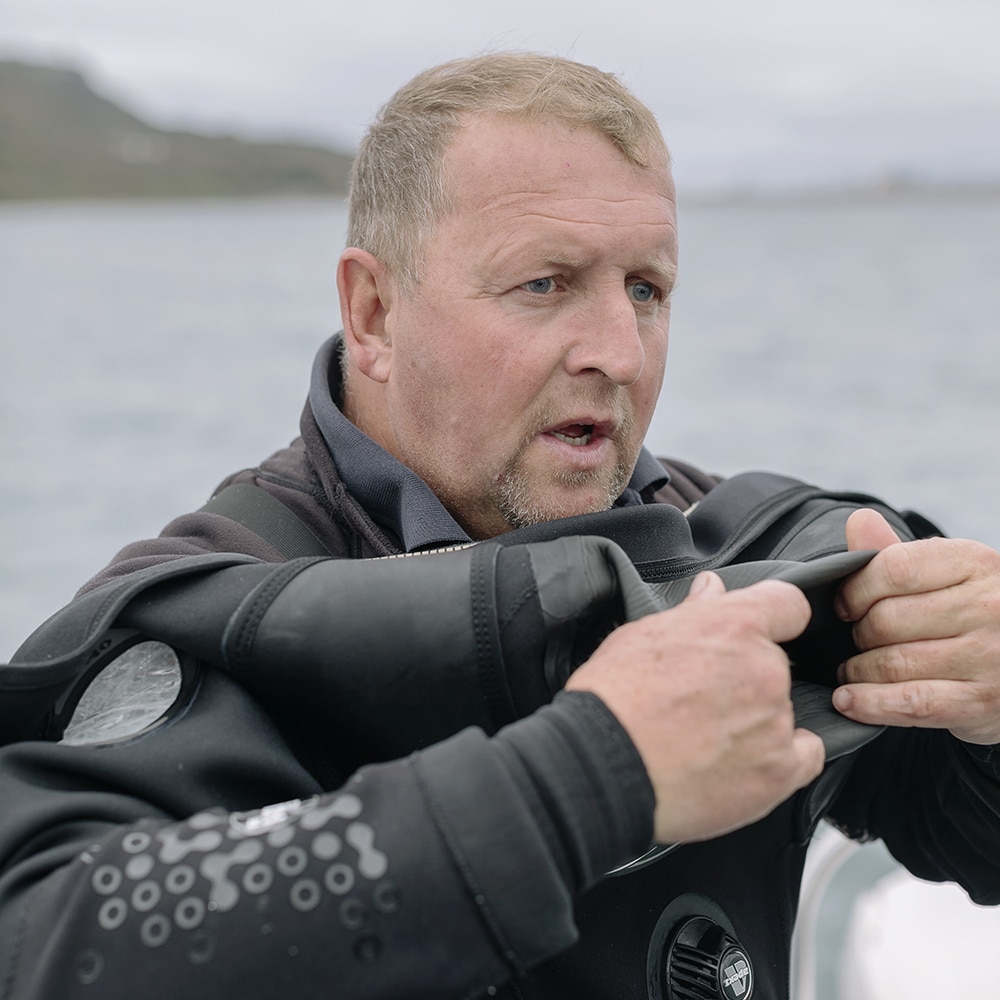
“It’s what I do,” he explains, loading a trailer with baskets, his suit and his fins (“Not flippers. Flipper is a dolphin, darling,” he corrects) and setting off to the mooring. Every morning is early, to catch the tide and some scallops or sea bass, and every night a late one, after an evening spent stalking the moors. Darren’s not complaining. “I have turned my passions and interests into a business,” he says – and it’s a successful one, too, in spite of some serious setbacks.
Of course, scallop fishing isn’t easy – at least, not the way Darren does it. Hand-diving only accounts for two per cent of scallops sold in Britain. Most of the scallops you’ll see in the shops will have been dredged, using what are effectively large metal rakes to scrape scallops – and inevitably, a load of other wildlife – off the seafloor.
“If this was on land, where people could see the havoc they cause, they’d stop it immediately. It’s like the moon down there after they’ve been at it. Everything is upside down, there’s no life at all.” It could take years to grow back, “if it ever does”. But attitudes are slowly changing. Here in Dorset, Darren’s vociferous campaigns against dredging have helped in getting it banned from several areas along the Jurassic Coast.
We board the Maddy Moo: still wet and shining from the deep clean she’s received this morning from Jeff Parish, Darren’s able seaman. “You should have seen her last night,” he grins when we comment on her shipshape appearance “after a seven-hour sea bass fishing trip”. They’d met with limited success on the trip: “Those bloody netters, they scoop them all up,” Jeff complains. Like the dredgers scouring the seabed, the trawler boats are the antithesis of the sustainable, man-versus-fish tactic of rod and line fishing. “You can be the best fisherman in the world, but you can’t catch fish if there aren’t any there to be caught.”
Today, though, Darren is hopeful as we chug gently out of the harbour. On the small black screen in the cabin the outline of the sea bed appears in green squiggles, including a huge naval boat sunk deliberately during the first world war to block the harbour entrance and defend it against German submarines. We slip over it easily, and are released into the grey-green plains of the English Channel. The cliffs are cragged and menacing but, as we come to a stop for Darren to slip into the water, the sea slapping the sides of our little boat is slack and peaceful. We’re at the sweet spot: the gap between tides.
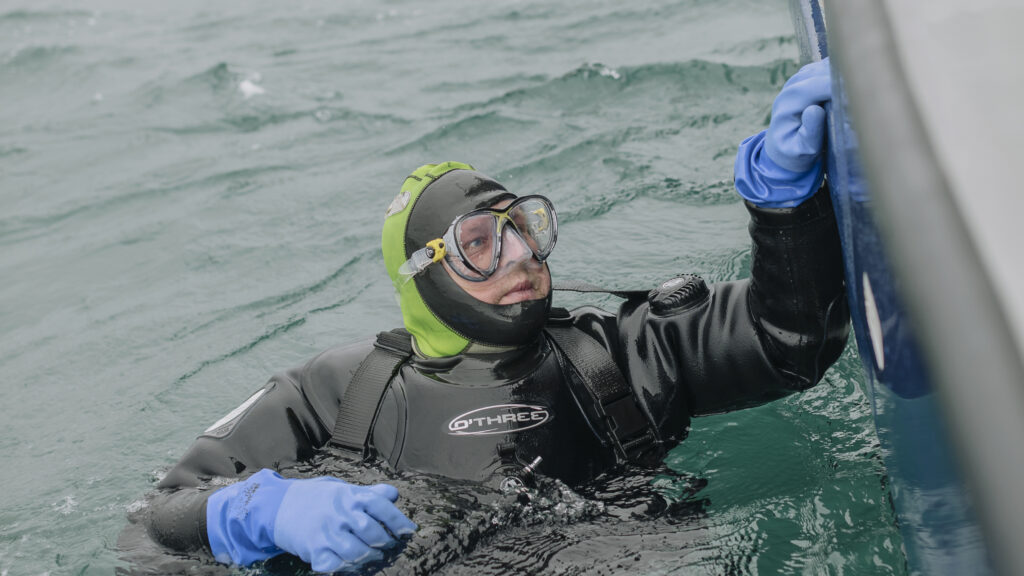
Slip is an understatement. With air cylinders, 32 pounds of weights around his waist and several baskets for collecting scallops, Darren’s entrance into the lolling sea is anything but slow. Even his suit is heavy: a thick, black skin of rubber. On his back, Darren is carrying my entire weight in tank, oxygen and mixed gases. “I’ll be working on 40 per cent oxygen today, which is twice as much oxygen as is in the air. That reduces my exposure to nitrogen which, if it becomes saturated in your blood and doesn’t have a chance to escape as you come up, gives you the bends. It is amazing isn’t it,” he says, fingering his mouthpiece, “that I am reliant on this little bit of rubber to keep me alive.”
In the pocket of his suit, Darren carries a flare. “I’ve been lost at sea for seven hours before. I’m not letting that happen again,” he says grimly. Tied to his belt are the net bags he will fill with scallops then send to the surface, by attaching them to what is effectively an inflatable balloon. He’ll have an hour, he reckons, before the flood of the tide kicks. “I’ve been doing this since I was a teenager. I could go round after someone less experienced and pick up twice as many as they have done. You get what you call the eye, for scallops.” Even while picking up one unwitting shellfish off the sea floor, Darren has one eye scanning the seabed for his next find. A flicker of movement; the flash of an orange frill; even just a slight indentation in the sand can denote a piece of buried treasure.
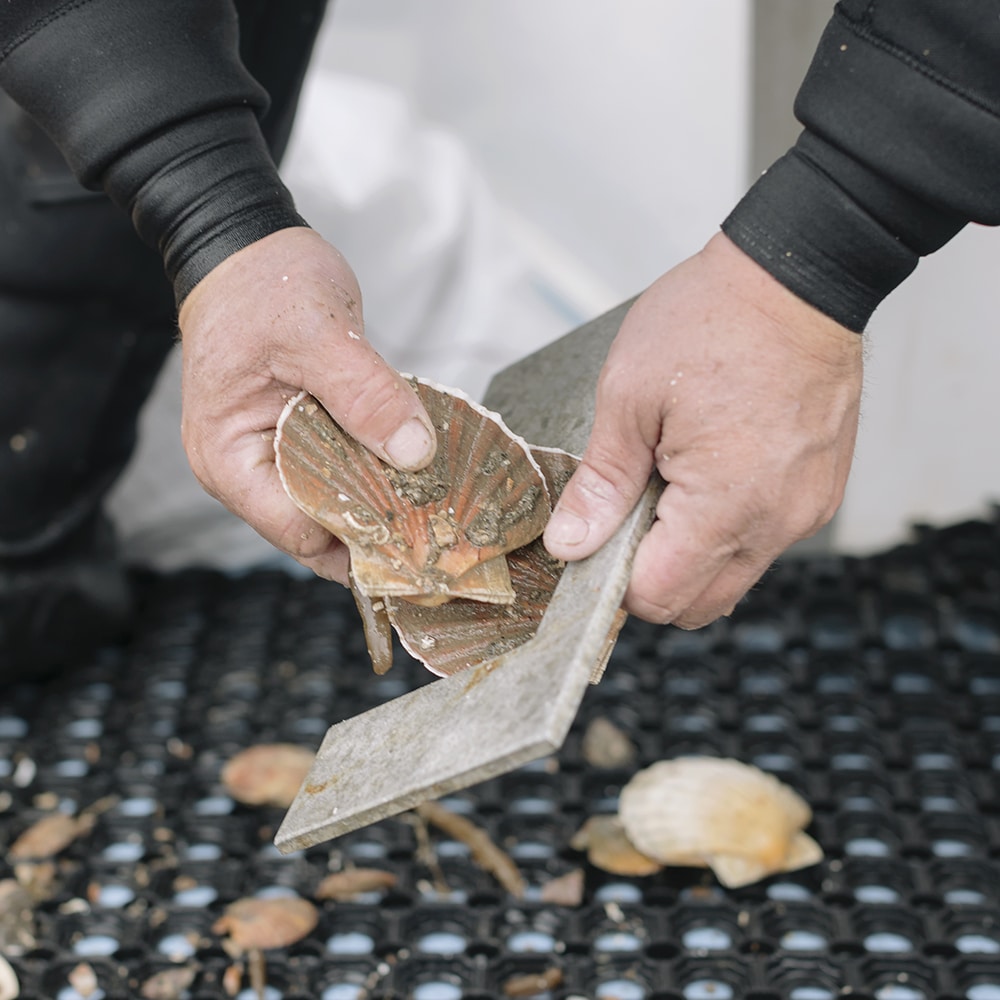
While Darren is in the deep, Jeff will be manning the boat, keeping his eyes peeled for the inflatable balloons that denote a fresh bag of scallops, and winching them up onto deck with the aid of a small crane.
“I’m going to jump over here captain,” Darren shouts, heaving the cylinders onto his back and diving into the water with surprising ease, if not all that much elegance. Jeff heads to the driver’s seat, ready to guide the boat toward his first find. “When the bag comes up I have to judge which way it’s going to float, and be downwind of it. There is no tide at the moment, so it all hangs on the breeze.” One thing you notice when you spend time with seafarers is how much information they can glean from their environment: the look of the sky, the sound of the sea – even the feel of the winds.
Jeff’s been fishing for as long as he can remember, though he has only recently started making a living from it. “I love the buzz of it,” he explains. As we chat, a red balloon appears about 50 metres away from us, and Jeff starts nudging the boat towards it, reading the wind all the while. Lining the crane up with the bobbing balloon is no mean feat. It appears static, but it’s moving rapidly across the surface and Jeff has to make an informed guess on its speed and distance. He leans over, hooks it to the crane and pulls it on board.
It’s overflowing: scallops, some weedy, some barnacled, all beautiful, spill out across the deck of the ship and Jeff starts sifting and sorting. All the scallops must be graded by size before they can be landed: the statutory minimum size for a king scallop is 100mm, and for a queen it is 40mm. Any smaller than that and they’re to be chucked back into the water, in order that they can continue to grow.
This is the other problem with dredging. Where Jeff and – when he resurfaces – Darren can measure each shell there and then, the dredgers have no such option. While the mesh collector bag attached to the dredge is designed to prevent the collection of undersized scallops, it is inevitable that some get caught up inside. These tiddlers are, eventually, returned to the waters – but there is some doubt over whether they can survive the experience of being dredged.
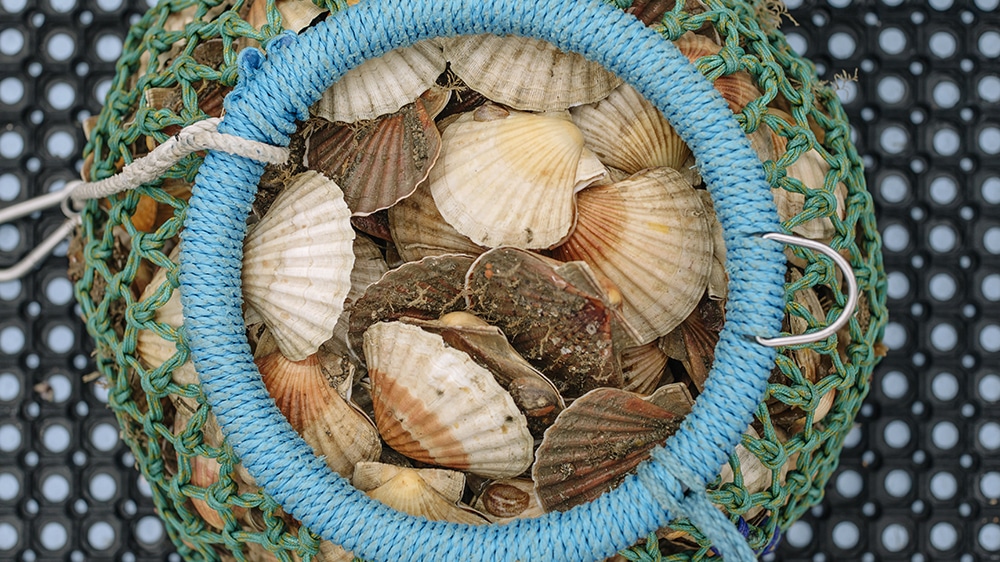
By this point two more balloons have popped up onto the surface – and not before time. “See that? There is a bit of flood kicking in already. He won’t be long now,” Jeff observes, scanning the surface. Eventually he resurfaces: his face triumphant against the steely grey of the water, and we make our way over to him. “There were absolutely stacks down there!” he puffs as Jeff leans down, seizes him by the back of his suit, and hauls him over the side.
Together, the fishermen gather up the last bag of scallops, and start sorting – largely by sight, but using a ruler to check those they’re unsure of. As the Maddy Moo makes her way back to shore, Jeff continues sorting, sending the undersized scallops flying gaily over the side. “Until next year!” I shout silently, as the little shells soar through the air and plop daintily into the sea, in the boat’s wake. In the meantime, we’ve a market to get to – and, as is tradition after a hard day’s work on the water, a swift half to drink.
Discover more
Q&A: Dominic Coyte
The owner of Borough Cheese Company on British food culture, raw milk, and his lifelong pursuit of the perfect cheese


“THE WORST THING ABOUT HAVING RICHARD HERE IS THAT HE DOES EAT A LOT OF THE PRODUCE – HE’S A BIG LAD”
Interviews: Viel Richardson / Image: Alice Mann
Jock on Richard
When he was around 10 years old, Richard would come to work with me on Saturdays in my greengrocers shop to earn his pocket money. He started helping me out at the Market when we began the retail stall about 17 years ago. He was a carpenter by trade but he always liked coming to do some work with me as well. He started full time on the stall about a year ago.
I think one of the things he likes most is engaging with people. He spent a lot of time working on building sites where there is bit of banter, but it is a closed in space – he enjoys the interaction you have with customers when working on a stall. He likes the variety of what we do, but particularly the wholesale buying side. You are there at 1am tasting the produce, developing relationships, picking out the best fruit you can find and then haggling over the price. It’s a very interesting part of the job.
Unlike me, Richard has quite exotic tastes in food – he’s really into trying things from different parts the world whenever he can. When he goes to the Market for lunch, he will always come back with something different from one of the Borough Market Kitchen stalls, or something interesting from one of the other greengrocers.
If I was going to give him one thing from the Stark’s Fruiterers stall it would be a passionfruit – you will often see him with one in his hand when they’re in. But I’d say that figs would come a close second. Whenever they’re good, he’ll eat loads of them. Working with him, I’ve discovered that he also loves cheese and chocolate brownies.
The worst thing about having Richard here is that he does eat a lot of the produce – he’s a big lad. But to be honest, there’s no real downside. We get on very well and we make a good team – as long as he does what I tell him!
Richard on Jock
My dad has been selling fruit and veg since long before I was around. He really likes the social aspect of it. He enjoys having a chat with the customers and the other stallholders, as well as the merchant bit of the business – the buying and selling and all the activity that the customers don’t see. He loves it when we’re out and about in the wholesale market in the middle of the night; you can see he gets a real buzz out of that, particularly the banter with the lads, some of whom he has known for years. He enjoys trying to spot the best produce and he really enjoys getting it for the best price. I think he just likes this way of life. He keeps threatening to retire, but I can’t see that happening any time soon.
He really knows his stuff. Even though I’ve been around this business all my life, I’m learning so much from him now I’ve started working here full-time. It’s not just the selling; it’s about doing the job well and running a good business. I’d rather he didn’t know I said that, though!
I wouldn’t call my dad a foodie. His tastes are quite traditional. He’s not particularly experimental in what he eats, but food is important to him and he recognises and appreciates good ingredients and good cooking.
I suppose after dealing with high quality ingredients for so many years, what my dad wants the cook to do is bring the best out of them. If you gave him £20 and sent him off into the Market, he would probably spend it all on fish. He’s really into his fish. If he did come back with anything else it would probably be lamb chops from Northfield Farm – he’s a real fan of those.
My dad can be a bit grumpy sometimes, If I’m honest, especially if I don’t do something his way. When that happens, he can get a bit upset. But we do have a good laugh. If you get on, which we do, there is nothing better than working with your family.
Q&A: Dominic Coyte
The owner of Borough Cheese Company on British food culture, raw milk, and his lifelong pursuit of the perfect cheese


“JEWS COMING TO THIS COUNTRY FROM ALL OVER THE WORLD BROUGHT WITH THEM THEIR OWN STYLES AND TECHNIQUES”
Interview: Clare Finney
What are the origins of salt beef?
The use of salt to preserve meat has been around far, far longer than salt beef as we know it today, in many different cultures. Yet salting meat can also be a way of koshering meat, because it removes the blood. It wouldn’t necessarily meet the strict criteria applied to koshering today, but it did the job historically, so Jews coming to this country from all over the world brought with them their own styles and techniques.
Where does your own salt beef recipe originate from?
It came through the family. My family had a delicatessen in Brick Lane, and the salt beef was made at my grandmother’s place on Hanbury Street, then brought round and sold in the shop. I’ve always been into food – my parents worked hard, so I used to cook the family meal, even as a kid. That’s where I picked it up. The recipe we use today at Nana Fanny’s is exactly the same as it was back then, with the same old-fashioned techniques.
What techniques are they?
First there is the brining process: immersing the brisket into our special brine to allow the flavour to penetrate through the meat, then leaving it there for a couple of days at an ambient temperature, turning it over regularly for an even distribution of brine. From there it goes to our kitchen – a basic set up, with converted ham boilers that look a bit like kettles. They have tight fitting lids, so there’s a lot of pressure inside. We boil the brined brisket in these for about six hours, with vegetables, herbs and spices to enhance the flavour, during which time the fat turns into a natural gelatine, renders down and is caught within the pockets of meat, so it becomes buttery and juicy. It’s then left to stand for a week, before being delivered to the Market, where it sits for another week in the refrigerator, before being brought up to room temperature on the stall and served.
How long does this whole process take?
From start to finish? Roughly three weeks.
Where does your beef come from?
It’s Irish brisket. It’s always Irish brisket: in European briskets that have been imported, the fibres are too tight, don’t produce the loose flaky meat people associate with salt beef. The cows are free range, pasture reared, and the farmer who supplies us is really keen on putting systems into place to mitigate their impact on the environment. They’ve planted woodland, and they only use biofuels now.
Is it kosher?
Not officially. In order to be classed as kosher, there is an authoritative body that would have to come and inspect all of our premises and processes. We’d have to have someone standing there while we’re serving, to make sure that kosher rules are adhered to. It would be impossible. We never imply our meat is kosher, though. And besides, our reuben sandwiches contain cheese, and that breaks all the rules!
Q&A: Dominic Coyte
The owner of Borough Cheese Company on British food culture, raw milk, and his lifelong pursuit of the perfect cheese


“ONCE AN ENJOYMENT OF THE CAPSAICIN COMPOUND HAS BEEN ACQUIRED, A DASH BECOMES A REGULAR NECESSITY”
Image: Regula Ysewijn
I’m very fond of the small glass condiment bottles that have a near-permanent place in my kitchen cupboards. There’s something strangely reassuring about these items, found lurking in the darker, stickier corners, at a height just beyond eye level – it’s a bit of a rummage every time I seek one, and rarely do I get the right bottle first time, but it’ll make its way to the counter top when required. Eventually.
No doubt our inventories are similar. I’m talking: a bottle of Worcestershire sauce, which is always between one third full and nearly empty, regardless of how recently I bought it; a couple of varieties of soy sauce; a sweet chilli sauce; some truffle oil; and several hot pepper sauces.
The latter category is vital. Not to everyone’s taste, I know. But once an enjoyment of the capsaicin compound that makes chilli peppers hot has been acquired, a dash becomes a regular necessity. It’s addictive: I splash hot pepper sauce on cheese on toast (both before and after the cheese goes under the grill); onto omelettes; over scrambled eggs and baked portobello mushrooms; into mayonnaise to pep things up a little; through soups and stews, particularly tomato-based ones and especially if there are black beans or tortillas involved. And I know others who employ it over many, many more things. The nutters.
Hot pepper sauces vary in character and colour depending on the chilli pepper, and where it sits on the Scoville scale of pungency. There’s the famous American one from Avery Island, USA, made from the tabasco pepper, and a massive range of Mexican hot pepper sauces too, which might be made from habanero, chipotle, guajillo, arbol, or piquin chilli peppers, or combinations thereof.
Punchy hot pepper sauces are a vital part of cuisine in the Caribbean islands. A few Trinidadian versions are conspicuous for employing maruga scorpion peppers – at 1,200,000 Scoville Heat Units (SHUs) one of the very hottest around, and too much for me (for more context, tabasco peppers measure 2,500-5,000 SHUs, chipotle 1,500-2,500 SHUs). Others use scotch bonnets, which tend to measure between 80,000 and 400,000 SHUs, so sure are hot, but they’re fruity too.
Though known for its Grenadian jams, jellies and spices, Green Market stalwart De La Grenade has two hot pepper sauces, both of which are worth a taste. There’s a yellow one, which is a common West Indian style – usually this is down to the use of onions, turmeric and mustard powder to temper the scotch bonnets, though De La Grenade’s is coloured by piccalilli, which adds a delicious piquant sweetness and provides a soft impact. But I really like the other one – the Forte sauce, which makes my lips throb and nose a little sweaty, without losing the taste of the peppers. Moreover, this is something that can be used as an ingredient as well as a condiment, as it makes an excellent and often vital addition to a marinade.
Hot pepper sauces are crucial in things like buffalo wing marinade, where it is incorporated into the mellowing comfort of melted butter – something similar would work well painted onto corn on the cob. But I love how De la Grenade’s Forte adds a warm tingle to papaya marinade. Use this on any tough, slow-cooking meat you’ve lined up for the barbecue, be that chicken thigh or lamb shoulder, as papaya contains an enzyme called papain, which is an incredibly effective tenderiser. It’s particularly good with pork steaks cut from collar or neck; the kind of things that might not be on a display, but the Market’s butchers will happily oblige if you explain what you’re after.
Q&A: Dominic Coyte
The owner of Borough Cheese Company on British food culture, raw milk, and his lifelong pursuit of the perfect cheese


“CANCOILLOTTE WAS DEVISED BY PEASANTS ANXIOUS THAT NOTHING GO TO WASTE DURING BUTTER MAKING”
“This is the cheese I suggest when people say ‘I can’t have cheese, I am on a diet!’” Florent at The French Comte grins, opening the lid of the cancoillotte. Pale, glossy, with the texture of extra rich and creamy yoghurt when cold and melting butter when hot, it does not look like a cheese which, Florent proudly boasts, is “one of the very few cheeses that’s less than 10 per cent fat”.
Nor does it taste like it. Sure, it’s no stilton, but it’s “flavourful rather than strong” and accommodates other flavours beautifully. Its closest comparison is mascarpone, the soft Italian cheese, but really, says Florent, “there’s nothing else like cancoillotte. It’s so original and local to our region that even Parisian friends haven’t heard of it” – Florent’s region being, of course, Franche-Comté in eastern France.
It’s been around since the 16th century, though the name descends from the 19th century word coille, which refers to the milk left after extracting cream. Devised by peasants anxious that nothing go to waste during butter making, cancoillotte came about through their practice of adding milk to the coille, before coagulating, cutting, pressing and ripening it to create a cheese known as metton.
Melt metton in a little water or milk over a low heat, Florent continues, add salt and butter, and voila! It’s cancoillotte, a cheese which, in its humble origins and its significance to the local community, is as rooted in the terroir and traditions of the Franche-Comte as the celebrated comté itself.
Perhaps – whisper it – even more so: for where comte is made solely from milk, producers of cancoillotte are wont to incorporate an intriguing array of local produce into the creamy cheese. “There’s the typical French cancoillotte with garlic, one with Jura wine – we sell both here, as well as the classic – and as it’s become more popular, people have developed cheese with shallots, truffles, or girolles.”
Florent’s producer, a family friend with whom he has worked for many years, even makes some with the local spirit, absinthe. “You don’t get hammered when you eat it,” he grins, “it’s actually very nice.”
For his own part, however, he’s partial to the classic, with its soft, creamy texture and buttery taste. “It is what you make it. Each cancoillotte is different” – for it is one of the few cheeses in the region still made domestically. Proud as he is of his highly esteemed producer, Florent’s fondest memories of this cheese are of eating it at home. “We would buy the metton and mum would make a big bowl of it for the family. It can be served in so many ways,” he enthuses: “hot in fondu, cold spread on bread, stirred through pasta, melted on vegetables. My favourite is cancoillotte melted over the local montbeliard or morteau sausage” – served, of course, with a glass of cote du Jura or vin Jaune.
